#it shows in the very way it portrays their stories and then villainizes or undermines them
Text
A (Negative) Review of Tom Taylor's Nightwing Run - What Went Wrong? Bludhaven (PART 1)
Introduction
Who is Dick Grayson?
What Went Wrong? Dick's Characterization
What Went Wrong? Barbara Gordon
What Went Wrong? Bludhaven (Part 1, Part 2)
What Went Wrong? Melinda Lin Grayson
What Went Wrong? Bea Bennett
What Went Wrong? Villains
Conclusion
Bibliography
Dick and Babs’ relationship also comes at the cost of something crucial: the citizens of Bludhaven.
Because Dick is often either with Babs or interacting with his other superhero connections, he does not engage with the people he is meant to protect. As a result, we as readers do not get to know the people of Bludhaven, much less grow to care for them. Bludhaven is barren. The only ones Dick interacts with are Babs, Titans, and occasionally Melinda. He is Bludhaven's protector but he has built no relationships with the people in his city.
When Dick’s apartment building blew up, Wally quite removed Dick from Bludhaven, robbing him of the opportunity to interact with his neighbors, with Clancy, or even his enemies. Having the Titans in Bludhaven further exacerbates this problem by creating a distance between Dick and the others in the city. Dick may be in Bludhaven, but he is not interacting with the people of Bludhaven. He literally lives in a tower removed from the rest of the population. Dick does not have a job of his own, we do not get to see him working for the Alfred Pennyworth Foundation, and because now he gets to be Nightwing more often, he is robbed of even more opportunities to experience a normal daily life in Bludhaven. By having Dick move into the Titan's tower, interact primarily with Babs and the Titans, and work solely as Nightwing, Taylor created a rift between Dick, his city, and its people.
As another Dick Grayson Fan put it in a discussion (From here on referred to as Dick Grayson Fan C):
“The problem [with the current iteration of Dick and Barbara’s relationship] has been there for years but what really brings it out in Taylor’s run - apart from DickBabs being attached at the hip - is that his Bludhaven is just very gentrified. It’s a reflection of the DickBabs relationship. And because Taylor can’t write more than one shallow plot, it’s the same for the Titans.”
Taylor’s Bludhaven is incredibly sanitized. It gestures at discussions of social justice without portraying them, it creates a simplistic black-and-white morality system that does not require the reader to be uncomfortable with the difficult realities of our world. The way Dick Grayson Fan C united both the Dick and Barbara romance and the portrayal of Bludhaven under the term “gentrification” perfectly captures how the relationship undermines the themes the story claims to care about.
Taylor’s Bludhaven has always been sanitized, but when the Titans show up, they displace Bludhaven citizens (literally moving into their neighborhoods, and figuratively by taking up the space Bludhaven citizens should have in a Nightwing story). Their relationship to Dick gentrifies the city and the story, making it so everything appears “nicer” and so Dick does not have to interact with the messier, more uncomfortable aspects of Bludhaven. He only gets to engage with those who are pristine, who share the exact same worldview as him, those affluent and privileged enough to dedicate their lives to superhero-ing without having to worry about being rent, paying bills, caring for their family, the stresses of a job, and any other problems.
For a world that is supposedly diverse, Dick only gets to have meaningful interactions with those whose heroic background and opinions on issues completely align with his own.
The Alfred Pennyworth Foundation would have been the perfect vehicle through which Bludhaven could have been fleshed out and Dick could have contributed to the care of his city while not being a vigilante. Yet, because Taylor tends to avoid conflict and makes it so everything must come easy to Dick, we are robbed of opportunities for Dick to grow, for the city to be fleshed out, and for the themes Taylor claims to care about to be fully explored.
Think about it: What reason do the people of Bludhaven have to believe that Gotham-native and newly billionaire Dick would keep his promise to create a shelter for their homeless youth population? Why should they believe that he is different from the other politicians or so-called philanthropists that took advantage of the system and of Bludhaven’s people in order to line their own pockets? And even if Dick was genuine in his efforts, why should they believe Dick would succeed when Blockbuster has the entire city under his thumb?
Dick never has to work to gain the trust of the citizens of Bludhaven. Because we are robbed of this conflict — that of Dick wanting people to trust him and people being reluctant to do so due to their past experiences — we are also robbed of a story that shows rather than tells the problems Dick tries to solve while also creating rich interactions between our protagonist and the people of his city. A conflict in which Dick has to prove himself to be trustworthy would have also given us the opportunity to meet and care for actual Bludhaven citizens, seeing them as individuals with diverse backgrounds, values, and personalities rather than a blank faceless mass.
Not only would a conflict in these early stages of Haven’s creation serve to develop Dick’s character, flesh out Bludhaven as a city with its own unique personality and problems, and create a side cast filled with individuals, but it would also work towards the main themes of the story. By denying us of said conflict, Taylor in turn makes his story weaker while undermining the thesis of his work.
On a bureaucratic front, Dick also faces no challenges. He never has to work to get his foundation started. After his announcement, we do not get to see him taking any of the practical steps required to run a nonprofit foundation and getting started on such a project. Furthermore, any bureaucratic challenges he should have faced given how the source of Bludhaven’s troubles are one of corruption, are easily waved away by Bea who later takes credit for this smooth ride, robbing Dick of agency and of his own accomplishments. Though Dick refused to acknowledge her work even as he received recognition for helping Bludhaven #113.
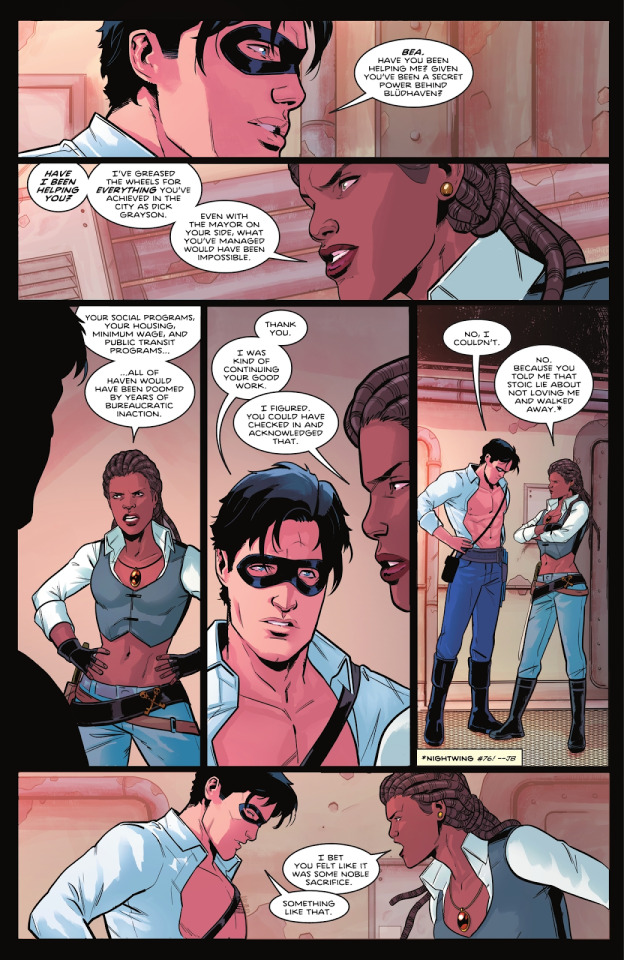
(Taylor, Tom, writer. Byrne, Stephen, illustrator. The Crew of the Crossed Part Three. Nightwing: Rebirth. 107, e-book ed. DC Comics, 2023. pp. 06)
Ordinarily, I wouldn’t consider that to be much of a problem. After all, the reason why Detective Comics and Batman comics do not focus on Bruce’s philanthropy is because that is not the focus of those stories (Though I once more feel the urge to note that Cataclysm and No Man’s Land managed to incorporate such elements into the main plot while still keeping the focus on the gang wars, superhero work, and detective investigation). But Taylor made The Alfred Foundation and Haven a centerpiece of the beginning of his run. In his attempts to address the popular online discourse about Bruce’s money being a solution to Gotham’s problem, Taylor made the idea that Bludhaven needed Dick Grayson’s philanthropic efforts to be their safety net a main theme of his story. For that reason, this plot element should have been a major focus, which means it should have been a main source of conflict in ways that showed just how Blockbuster’s cruelty affected the disposition of Bludhaven’s citizens.
The absence of conflict and tension in the story point that is so pivotal to Taylor’s run demonstrates not only Taylor's underwhelming abilities as a writer, but also how he approaches writing not with a focus on storytelling, but rather with a focus on online discourse.
Scholar Steve Braxi highlights this as one of the main problems in Taylor’s writing when examining both Nightwing and Superman: Son of Kal-El in the essay On Superman, Shootings, and Realities of Superheroes. There, Braxi dismantles criticisms against the “socio-political” responsibilities of fictional superheroes by arguing such critiques to be in bad-faith for demanding “political solutions from fictional realities.” According to him, in these arguments, “Superman and Batman are not treated here as ideas readers want to believe in, but rather people that need to prove their worth to us. They need to take on real issues in their fictional world in order for their fictional solutions to speak to our real world. This equivalency between their world and ours has a dissonant effect on me because I think it misunderstands the entry point of fiction in the first place.” (Braxi, Steve, “On Superman, Shootings, and the Reality of Superheroes” Comics Bookcase, September 2021)
Taylor’s decision to make Dick a billionaire who uses his money for the social benefit of others is a response to popular online discourse about whether Bruce Wayne should use his money to help Gotham in ways other than Batman. While I already pointed out that such arguments ignore the fact that Bruce does, canonically, use his wealth to the benefit of others, Braxi points out that “the argument that Superman ignores real social issues or that Batman is worse than the crime he fights does not assume the best intentions of the characters, creators or nature of fiction. They engage with these stories from a perspective that is intentionally distant from the unique reality of the story being told.” (Braxi, Steve, “On Superman, Shootings, and the Reality of Superheroes” Comics Bookcase, September 2021)
Braxi rightfully argues that attempts to respond to shallow criticism leads to shallow storytelling. It is only because these are popular online arguments that Taylor makes them important plot points in his story. And yet, despite their supposed importance, the Alfred Pennyworth Foundation and Haven are not properly incorporated into the story because Taylor does not take into consideration what these elements say about his characters, his themes, and how they can shape the plot on a deeper level. As such, the lack of meaningful conflict can be seen as a symptom of this thoughtlessly performative desire to play into trendy discourse. Character complexity, narrative depth, and thematic cohesion are all sacrificed to please an ever changing social media algorithm and debates that are forgotten and disregarded in a matter of days.
Even the Alfred Pennyworth Foundation’s name is, quite frankly, evidence of such online fan pandering at the cost of characterization and narrative. Alfred is beloved by many, and while we do not have time to discuss DC’s attempts to sanitize his character after his death (While I adore Alfred, he had many flaws that affected the manner in which he raised Bruce and Dick. These flaws, however, have been ignored or erased by current comics that prefer to portray Alfred as a benevolent father figure who never made any mistakes. While I believe Bruce and Dick would glorify Alfred in such a manner, that does not mean the narrative has to agree with their biased perspectives),
the reality is that though Alfred may mean a lot to Dick Grayson fans, he means nothing to the people of Bludhaven. From my personal point of view, Alfred was also not the type of person who would have liked to have a statue in his honor in a city he never visited. From an in-universe perspective, naming a nonprofit meant to help the people of Bludhaven after a man who did not even live in their city and then erecting a statue in his honor makes no narrative sense. But Taylor does it because the statue means something to the audience, regardless of how that would play in-universe.

(Taylor, Tom, writer. Redondo, Bruno, illustrator. The Battle for Bludhaven’s Heart. Nightwing: Rebirth. 92, e-book ed. DC Comics, 2022. pp 12)
Furthermore, by not having Dick interact with the people of his city, Taylor contradicts his supposed characterization of Dick as a “good guy.” This is yet another instance of telling and not showing, and it is most obvious when looking at Heartless.
Though Taylor tried to build up Heartless as this intimidating villain, he put little effort into matching said intimidation with the appropriate amount of urgency. Dick does not treat Heartless as an actual threat. This, as mentioned previously, transforms Dick into a self-absorbed man who does not understand (or does not care) about dangers being posed to the people of his city.
From both a narrative and a character standpoint, the fact that the children of Heartless’ victims mirror Dick’s own experience makes this disconnect even more frustrating.
Dick lost his parents. He knows what it feels like to see their dead, bloody bodies on the floor when you’re but a small child. Dick also knows how finding justice can help with closure, and how not finding justice can haunt you for the rest of your life. Knowing that Heartless made countless kids into orphans should be a crucial motivation for Dick to fall into that intense and obsessive pursuit that characterizes his crime fighting. Dick should be working on this case constantly, for he knows what those kids are going through. Dick appointed himself their protector, yet he does nothing for them. He does not guide them through their grief the way Bruce did for him, he does not find justice for their parents the way Batman and Robin did when they captured Zucco, he does not offer them closure or an outlet for their anger and their pain. The story does not show Dick to be a hero, but rather, it makes him into an incredibly selfish, lazy person who is only interested in the optics of heroism, and not the, often thankless and unacknowledged, work it takes to actually help people.
The contrast between how Dick is Nightwing: The Untouchable and Taylor’s run could not be greater. The former carried every death on his shoulders, determined to push through bullet wounds in order to prevent more killings. The latter behaves as if Heartless did not exist unless he is on screen.
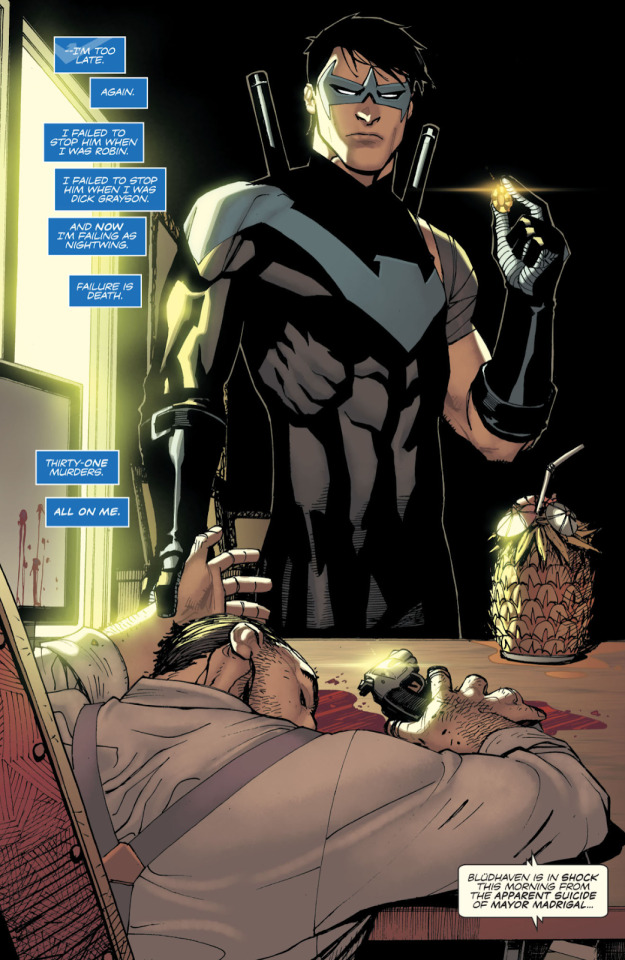
(Humphries, Sam, writer. Chang, Bernard, illustrator. The Untouchable: Chapter Two: Relentless. Nightwing: Rebirth no. 36, e-book ed. DC Comics, 2018. Page 20)

(Wolfman, Marv, writer. Igle, Jamal, illustrator. Bride and Groom: Part One: The Courtship. Nightwing no. 129, e-book ed. DC Comics, 2007. pp. 11)
That is because Wolfman understood that the best way to show Dick’s compassion was to have him interact with those whose lives were made better by his presence. As readers, we were able to experience first-hand the difference Dick makes on an individual and personal level. This is more than just having Nightwing appear in a pencil case; this shows Dick actively interacting with the people of his city, forming genuine connections with them, and putting in the work to make their lives better because he cares.

(Wolfman, Marv, writer. Luque, Paco Diaz, illustrator. Bride and Groom: Part Four. Nightwing no. 132, e-book ed. DC Comics, 2007. pp. 24)
Please understand that I am not saying that Heartless should be present in every single issue, from the moment he was introduced to the moment he is finally caught. But just because he is not physically there, it does not mean that the story should not be exploring the effect his actions have on his victims' loved ones. Readers should see the terror that grips Bludhaven as a serial killer is on the loose. How do people, especially the homeless youth Dick vowed to protect, react when they don't feel safe? Heartless doesn't need to be physically there, but his presence and its effect should still be felt. That's what happened with Blockbuster in Nightwing (1996) – he may not have been there all the time, but his grip on Bludhaven, on the corrupt systems, on Dick's life, was still always present.
By depicting Heartless’ effect on Bludhaven would not only add urgency and stakes to the plot, it would give faces to his victims while giving Dick the opportunity to bond with the people of Bludhaven. Perhaps as Heartless’ orphans come together in their grief and anger, and once they realize that the corrupt BCPD isn’t going to bring justice to their parents, they decide to take matters into their own hands. Then Nightwing could step up and prevent them from going too far. He could teach them productive ways to channel their anger, give them shelter and an empathetic ear, and he would vow to do right by them when no one else did before. This would show Nightwing’s love for Bludhaven and it would bring the themes of inequality and social justice that Taylor claims to want to explore into the narrative in a more emotionally effective manner, for the homeless youth would have names, faces, and their own voices.
There doesn’t even need to be many children. In fact, there could be just one — Elliot, from #79.
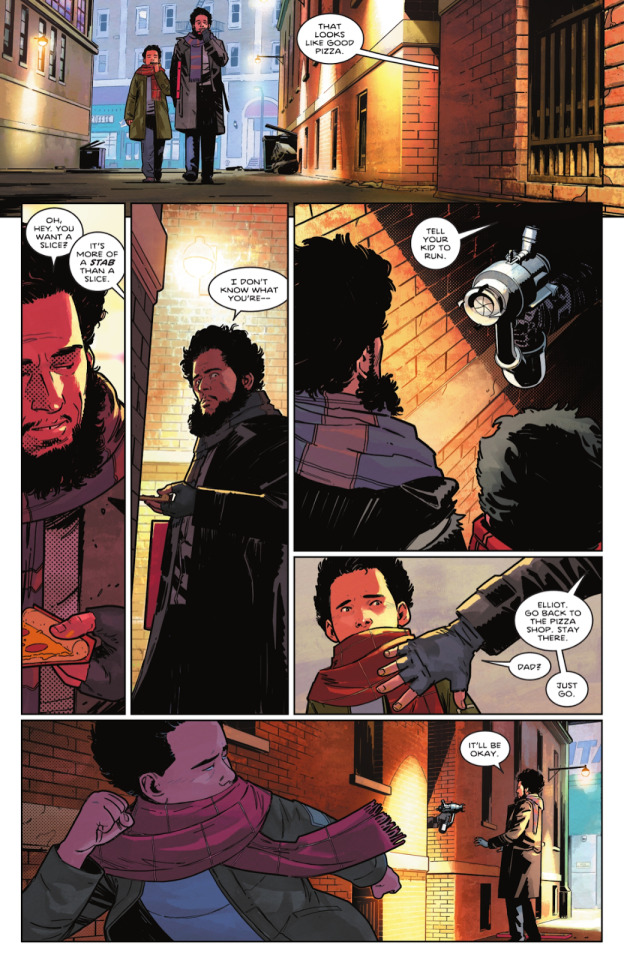
(Taylor, Tom, writer. Redondo, Bruno, illustrator. Leaping into the Light Part Two. Nightwing: Rebirth. 79, e-book ed. DC Comics, 2021. pp 11)
By making Elliot the face of Heartless’ true evil, the face of the victims of Bludhaven’s corrupt system, of people’s lack of compassion, Taylor would show the reader everything Dick wants to fix in Bludhaven and why it needs fixing. Elliot would humanize these abstract concepts so that the reader is emotionally invested in Dick’s success. The stakes are suddenly personal. Furthermore, it would prevent the city from feeling so barren while giving Dick people to care for outside of his already established connections. Just as Bruce did with him, Dick could see much of himself in Elliot, and that would lead him to want to help Elliot in a similar way Bruce helped him all those years ago. This also would have contributed to making the hug in #100 more effective, as it would be creating mirrors and parallels between Bruce and Dick’s relationship, and Dick’s relationship to Elliot.

(Loeb, Jeph, writer. Sale, Tim, illustrator. Orphans. Batman: Dark Victory. 09, e-book ed. DC Comics, 2000. pp 05)
The fact that it took over thirty issues for Taylor to finally, finally, draw a connection between Bruce, Dick, and Heartless victims in #111 is, frankly, lazy and thoughtless.
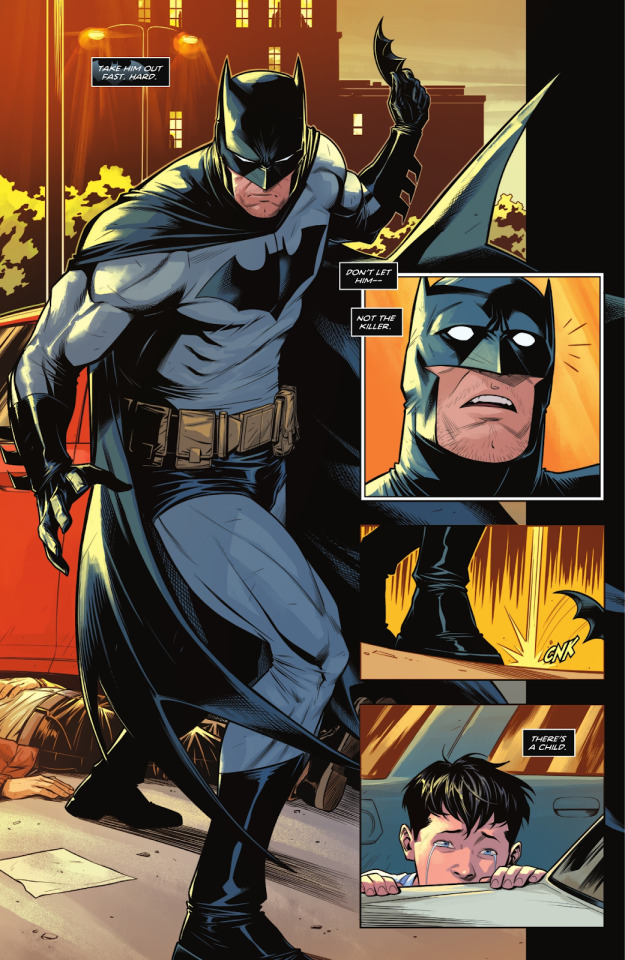

(Taylor, Tom, writer. Basri, Sami, illustrator. Nightwing. Nightwing:Rebirth. 111, e-book ed. DC Comics, 2024. pp 05-06)
In his 2022 video titled The Secret Ingredient That Makes Raimi's SPIDER-MAN So Great (Season Premiere), video-essayist and film critic Patrick H Willems discusses how vital of a role the ordinary citizen characters played in the Sam Sami Spider-Man trilogy. He describes how “they make the New York of these movies feel like a real, thriving city populated by a vibrant community of characters. Because if we’re going to care about Spider-Man caring about the people of New York, we have to actually get to know the people of New York.” (Willems, Patrick H. “The Secret Ingredient That Makes Raimi's SPIDER-MAN So Great (Season Premiere)” Youtube, uploaded by Patrick (H) Willems, 20 September 2022 https://www.youtube.com/watch?v=xFpQBOopf84)
Similarly, giving Bludhaven citizens, giving Heartless’ victims agency and individuality would have elevated the story and made Dick into a more empathetic and endearing hero. We would have cared about the people of Bludhaven because we would have gotten to know them through their interactions with Dick.
But to accomplish that, Taylor would have to actually care about who Dick Grayson is and who the people of Bludhaven are; he would need to actually care about the story he is trying to tell as a whole, rather than simply writing for moments that will merely appear progressive when removed from their context and presented on social media.
To be perfectly fair to Taylor and Redondo, they are hardly the only ones to miss an opportunity when it comes to Bludhaven. Even Dixon and Grayson, the first two who were given the chance to breathe life into this city, were satisfied to treat Nightwing’s abode as merely “Gotham lite.” In fact, much could be said about DC’s handling of Bludhaven, its lack of investment in the city, the ways in which it tried to erase it from its history, and what parallels can be made with how many in DC view Dick Grayson. What sets Taylor and Redondo’s mishandling apart from all others was that, instead of depicting Bludhaven as a generic corrupt city, they opted instead for a gentrified, picturesque liberal urban utopia. As Taylor’s Nightwing perfectly said when confronting Blockbuster, Roland Desmond is the one big identifiable bad guy who is shown to be the source of all of Bludhaven’s problems.
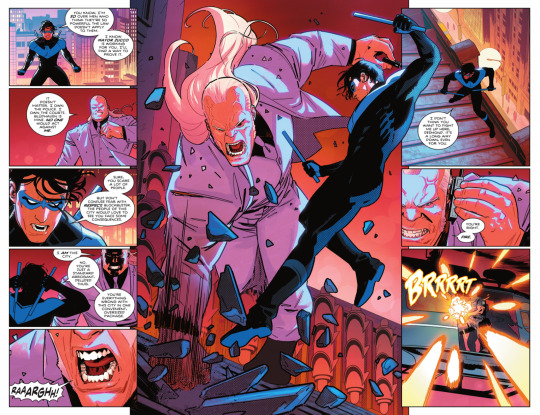
(Taylor, Tom, writer. Redondo, Bruno, illustrator Leaping into the Light Part Six. Nightwing: Rebirth. 83, e-book ed. DC Comics, 2021. pp. 08)
Like Gotham, Bludhaven is broken in a myriad of ways. While many of their problems come from those on top, both cities also face mundane evils that rise from not just suffering, but apathy. There are many stories about Gotham that explore the dark and the light side of humanity, acknowledging that both of them can be found in us. It was a small evil that killed Thomas and Martha, but it is a grander, structural evil that prevents justice from being served and hinders Gotham from prospering. It was also a grander, structural evil and corruption that put Joe Chill in a position where he held a family at gunpoint and murdered a mother and father in front of their young child.
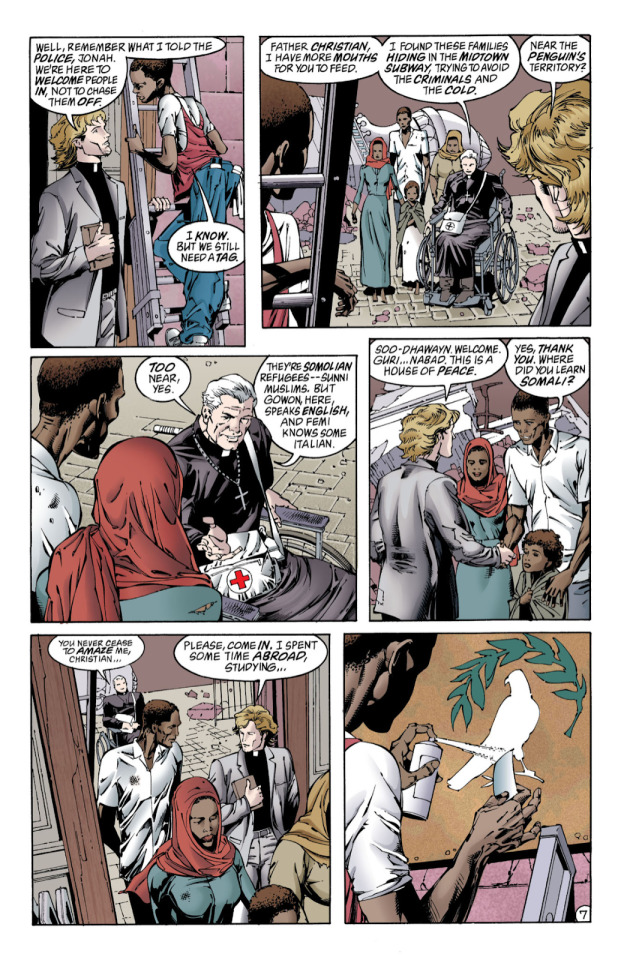
(Grayson, Devin, writer. Eaglesham, Dale, illustrator. Fear of Flames Part One: Fanning the Flames. Batman: Legends of the Dark Knight. 116, e-book ed. DC Comics, 1999. pp. 07)
Bludhaven is often characterized as Gotham’s little sister. In fact, it was the fact that the city reminded Dick so much of a Gotham without a Batman or a Gordon that Dick decided to take on the challenge of caring for Bludhaven. He saw a city in need, knew he could do something to help it, and so he did.
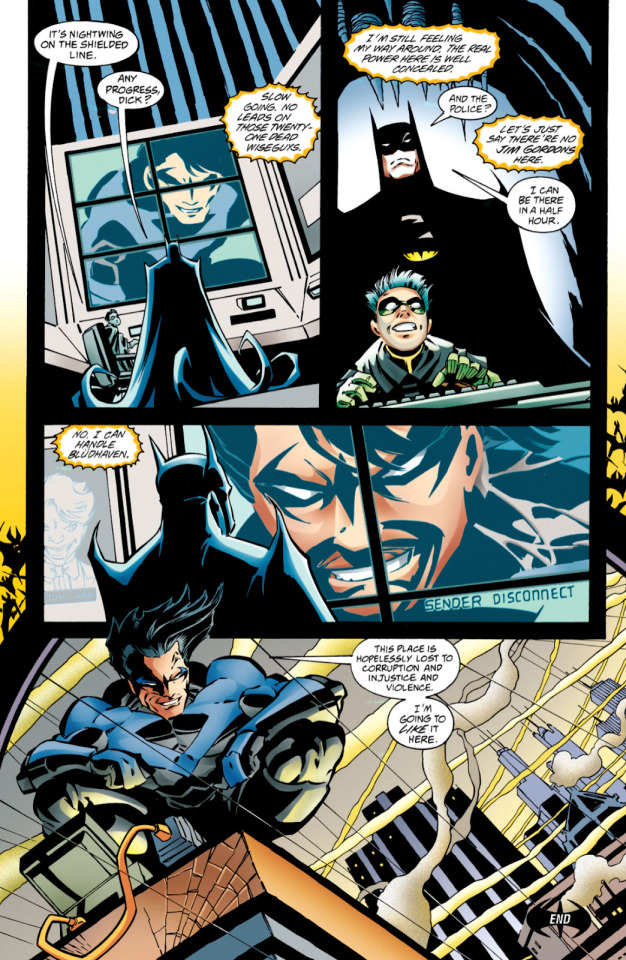
(Dixon, Chuck, writer. McDaniel, Scott, illustrator The Freebooters. Nightwing. 03, e-book ed. DC Comics, 1996. pp. 23)
Just Batman struggles in No Man’s Land when there is no system to uphold, the beginning of Dixon’s run is characterized by Dick struggling with the lack of allies or of a network in which he could trust. As Tim pointed out to him in Nightwing #06, Dick was all on his own.
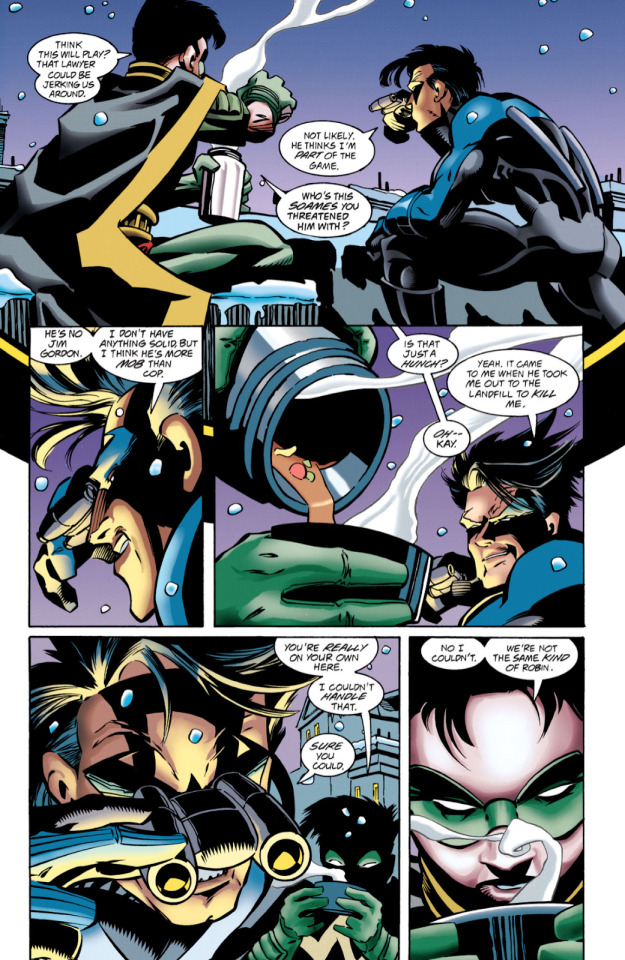
(Dixon, Chuck, writer. McDaniel, Scott, illustrator The Visitor. Nightwing. 06, e-book ed. DC Comics, 1996. pp. 12)
Tim Seeley also emphasized this isolation in his run, though in this scenario, Dick purposefully sought out this separation in hopes that being in Bludhaven would help him discover who he is.
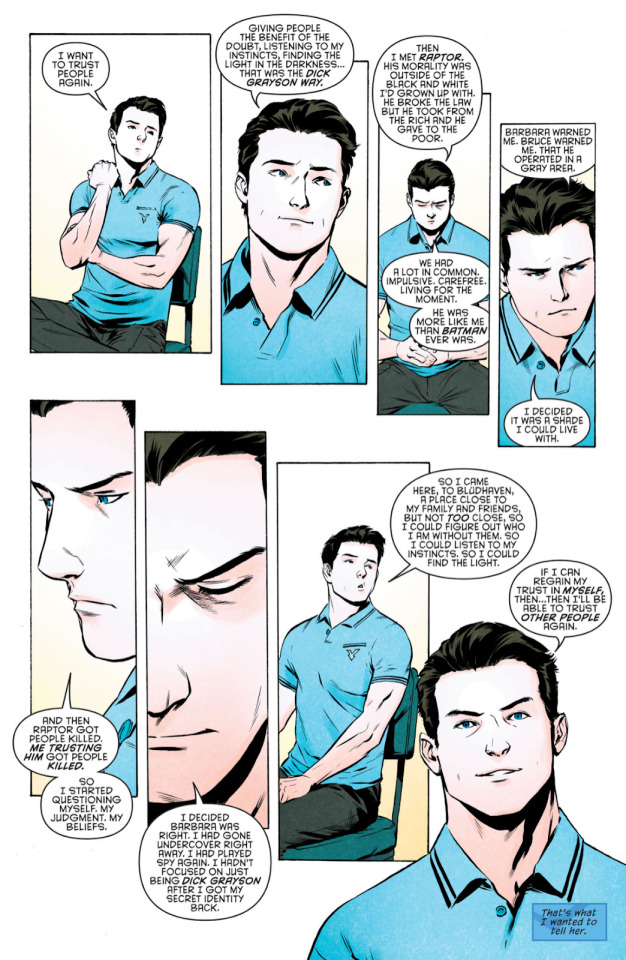
(Seeley, Tim, writer. To, Marcus, illustrator Bludhaven: Part One. Nightwing: Rebirth. 10, e-book ed. DC Comics, 2016. pp. 08)
As both runs progress, Dick slowly builds his own network of alliances. In Dixon’s run, which seems to be the one that, given Blockbuster’s presence, most inspired Taylor, Dick learns how the city operates and crafts a strategy that balances tackling emergencies, disrupting the system, and slowly untangling the messy rot beneath without causing unforeseen negative consequences.While Dixon’s run is filled with problematic elements in its own right (especially when it comes to the portrayal of women and even some aspects of Dick’s characterization), this section will be focusing on how the narrative provides opportunities for Dick to interact with the ordinary people of Bludhaven. (Taylor drawing inspiration from Dixon’s run can be observed not only on the similarities between the plot points [though he retreads mainly Grayson’s run rather than Dixon’s], but also by Taylor’s own admission. In February 2024, when Dixon posted a homophobic tweet about Jon Kent and Dick Grayson, Taylor expressed his disappointment over Dixon’s attitude and cited how Dixon’s run was an inspiration to him.)
Clancy becomes a bridge between Dick and his neighbors, who represent different facets of Bludhaven.

(Dixon, Chuck, writer. McDaniel, Scott, illustrator. False Starts. Nightwing. 21, e-book ed. DC Comics, 1998. pp. 13)
Through his work as a bartender he gains insight into cold cases, learns more about the Bludhaven City Police Department.
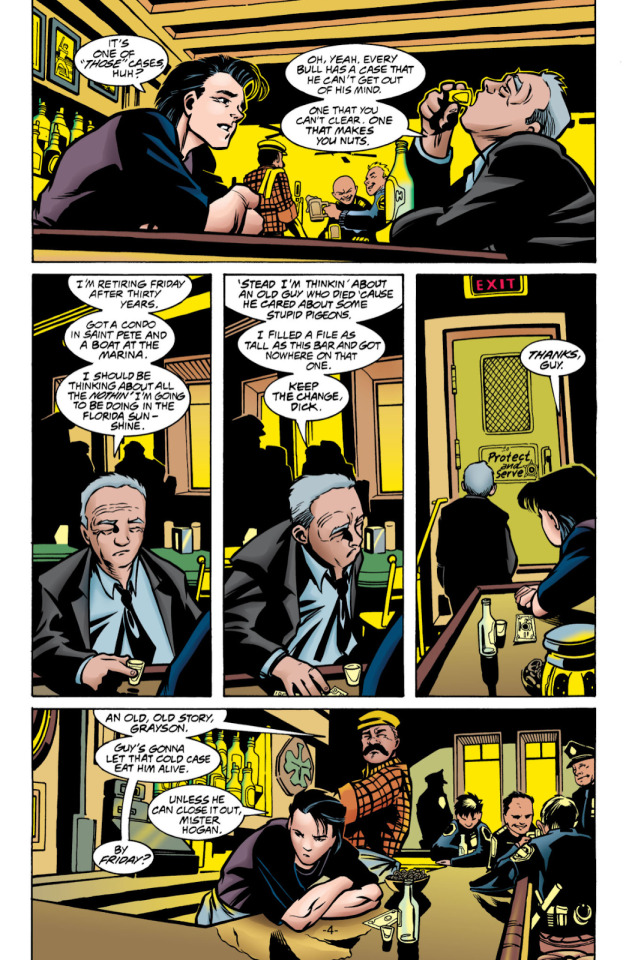
(Dixon, Chuck, writer. McDaniel, Scott The Forgotten Dead. Nightwing. 24, e-book ed. DC Comics, 1998. pp. 24)
He befriends his partner Amy Rohrbach, and with her, he learns about the small alliance of clean cops that are trying to overthrow the current dirty officials.

(Dixon, Chuck, writer. McCarthy, Trevor, illustrator. The Threshold. Nightwing. 60, e-book ed. DC Comics, 2001. pp 08)
Similarly, Grayson's run shows us the complicated politics of the city’s underworld, presenting the reader with a myriad of characters. While Dick certainly encounters greedy mobsters interested only in using violence as a means to gain wealth
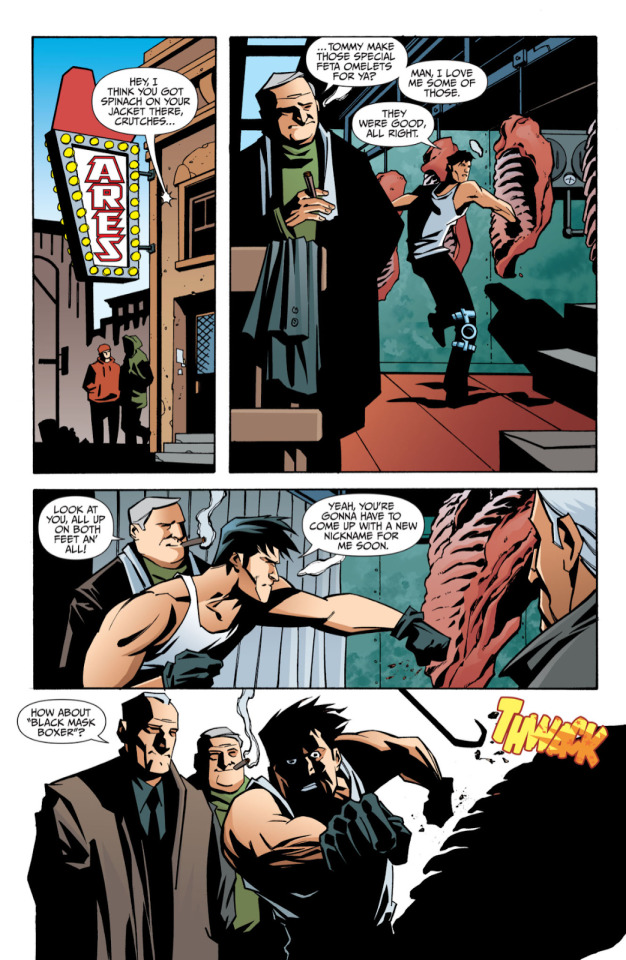

(Grayson, Devin, writer. Hester, Phil Cold Turkey. Nightwing. 109, e-book ed. DC Comics, 2005. pp. 11 - 12)
Dick also interacts with those who ended up caught up in such a dark world through no fault of their own. When Dick, acting as Crutches, beats up a mobster, he discovers his innocent girlfriend and the girlfriend’s child were in the house. While Dick, as our hero, did not allow any harm to come to them, the trauma they went through is not ignored by the narrative.
In fact, not only is it acknowledged, but when Angie Malazavos comes to the police with information on the mob — something that could only happen thanks to Dick and Amy successfully removing a majority of dirty cops from position of power — we see that trauma repeated as the police raids the house of the mobster who began the attack.
Memorably, this leads to Sophia Tevis, the fifteen year old daughter of said mobster, to not only become an orphan, but embody that uncomfortable synthesis of crime and innocence after she witnesses her entire family — a family who loved and doted on her — being killed by the police
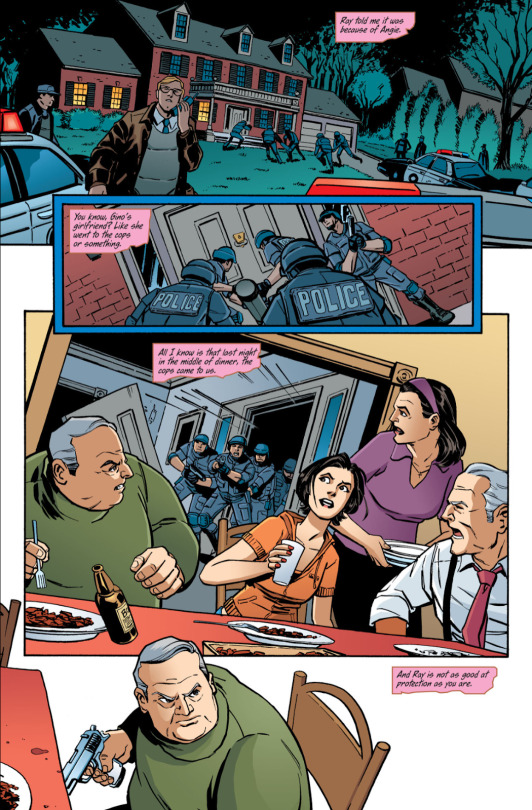
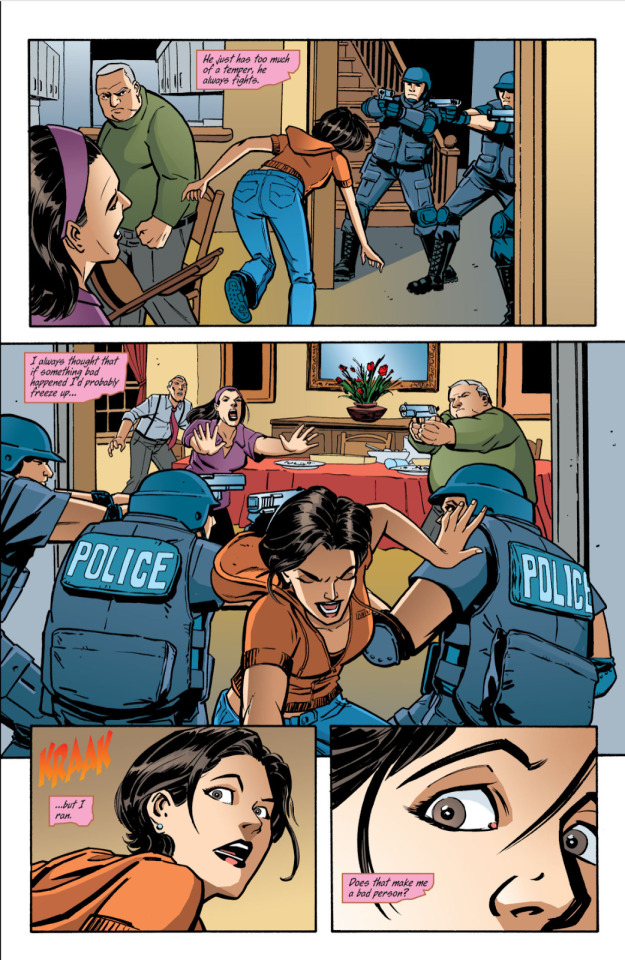

(Grayson, Devin, writer. Chiang, Cliff, illustrator. Signed, Sophia. Nightwing. 111, e-book ed. DC Comics, 2005. pp. 5 - 7)
As he takes her under his wing, Dick and the reader are forced to confront the unclear position people like Sophia occupy in a world that attempts to create clear divides based upon not only actions and motivations, but relations.
By contrast, Taylor’s Bludhaven is too… Nice. Like his characters, it lacks any substance or personality, being a shallow and bland setting without true flaws or appeal. By blaming Blockbuster and his cronies for all that is wrong in Bludhaven, Taylor cheats himself of the opportunity to give Bludhaven flavor. He creates a world where either you are a rich man taking advantage of others or you are a helpless victim who has a good heart and will always be selfless.
This simplistic morality and the surface-level portrayal of Bludhaven as a city not only proves that Taylor gives the city he is writing about no true thought, but it also shows how Taylor’s supposed interest in progressive messages and socially-conscious themes is an incredibly shallow one. After all, if Taylor truly wanted to explore themes of class inequality and systematic injustice, then such a simplistic moral approach works against the innate human messiness and structural complexities inherent in these themes. It is not the themes or its messages, therefore, that interest Taylor, but rather the prestige that comes from being viewed as someone writing about these issues.
This once more shows that Taylor does not care about the story he is telling, the characters in his care, the themes he brings up, and the city whose legacy is in his power to shape. He is not approaching his run from the perspective of a writer, but rather, of a person who chases clout on social media.
As Braxis pointed out in his article, engaging with these themes is difficult. Engaging with it well — truly entering the conversation about real world political, social, and economic problems — is even more so, especially when you also have to tell a satisfying story that does come across as preaching. More than that, though, a story that so directly confronts these issues must, in order to be effective, force the reader to come to terms with their own culpability in a system that is far larger than the individual. It must force us to be uncomfortable and have us ask ourselves how we can bring on change, even in some small way. If such stories are not willing to have the reader be truly emotionally uncomfortable, then they are simply appropriating the pain and suffering of others for a bit of socially progressive coat of paint.
Taylor does not want his readers to be uncomfortable. He does not wish to upset them. He does not wish them to worry or even feel the slightest bit of tension by having Dick be wrong or someone say something mean. He refuses to portray all the many ways evil can manifest in society, all of the petty cruelties everyday people inflict on each other, the apathy of those who are comfortable, the way many must force themselves into individualistic selfishness in order to survive or in order to protect those they love. Taylor doesn’t allow for the pettiness in his world, where, in #87, even a random passerby must happily offer up his bike to Nightwing without questions or expectations.
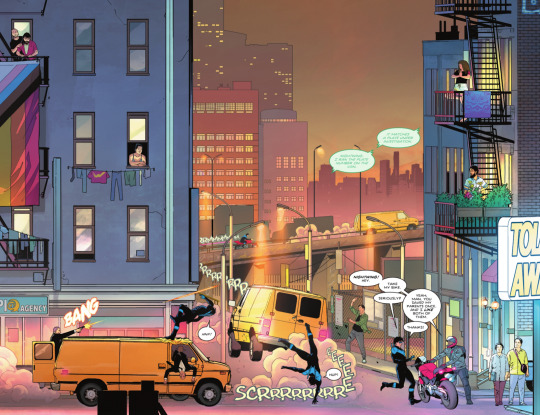
(Taylor, Tom, writer. Redondo, Bruno, illustrator. Get Grayson. Nightwing: Rebirth. 87, e-book ed. DC Comics, 2021. pp 08)
Taylor’s depiction of Bludhaven betrays a very juvenile idea of what good and evil means, a very simplistic idea of how the world works, and very easy solutions to fixing difficult problems, with all of the woes being “fixed” when good guys like Dick, Babs, and Melinda are in power. If you are not one of the main characters, then you are either a corrupt criminal using their money to take advantage of people, or you are a poor helpless victim. There’s no in between, no space for the mundane evils of the world or the average heroics of average people.
As Braxis pointed out when discussing the superficiality of Taylor’s social critique:
Son of Kal-El and Nightwing demonstrate a pattern in Tom Taylor’s writing where social issues are used as plot devices, but there is a performative contradiction this ends up creating. Jon and Dick are exposed to social issues as a gateway to criticize their mentors. However, their lack of understanding about the issues they’re exposed to means their own criticisms can be thrown back at them.
(Braxi, Steve, “On Superman, Shootings, and the Reality of Superheroes” Comics Bookcase, September 2021)
Please note that I'm not saying that exploring class inequality and systematic injustice aren’t interesting lenses through which one can explore Bludhaven. However, by making Bludhaven such a friendly yet passive city, Taylor stumbles onto a trap of his own making. He uses no metaphors, no allegories, no symbolism, no fantasy or science fiction elements to create distance between the narrative and the real world, allowing more freedom with how these topics could be discussed. Taylor decided to tackle, as Braxis characterized, “shallow criticism, a criticism in bad faith” by directly engaging with these real world problems, and as such, he took on work that was not only far beyond his capabilities as a mediocre writer, but work that he clearly has no interest in undertaking.
To have to read about this Bludhaven after we had Humphries and Chang’s depiction feels even more like a knife to the heart of every Dick Grayson fan.
Humphries’ The Untouchable, Bludhaven’s corruption and evil is beyond “generic” police corruption. It is specific. It is unique. Bludhaven has a history. It has personality. Humphries’ run touches on themes of corruption both through the fantastical use of the Judge, and by the very specific scenario of Bludhaven’s unique economic problems. This Bludhaven’s economy is so deeply tied to a rotten, corrupt system that everyone ends up being both victim and perpetrator. The system harms all of them, but without it, they cannot survive.
The casinos were corrupt, stealing money from schools, lining its owners pockets, controlling the mayor through bribery and blackmail. But Bludhaven is also dependent on the casinos. Its economy is entirely dependent on them to the point that even those who do not work directly with the casino still need them to thrive. This creates a fascinating and complicated scenario where weeding out the corruption that led to so much suffering will not solve anyone’s problem. In fact, as the story demonstrates, it can even make it worse.

(Humphries, Sam, writer. Chang, Bernard, illustrator. The Untouchable: Chapter Two: Relentless. Nightwing: Rebirth no. 36, e-book ed. DC Comics, 2018. pp. 21)
For a more concrete example of how Humphries and Chang were able to flesh out Bludhaven in five issues so much more than Taylor and Redondo did throughout all these years, I want to compare Humphries’ handling of the Justice Tree with Taylor’s handling of the Octopus statue in the beginning of his run.
Humphries’ Justice Tree not only creates a concrete and identifiable landmark within the city, not only is it connected to Bludhaven’s history, The Untouchable’s main antagonist, and Dick’s personal relationship with the city, but it is also tied to the themes of the plot.
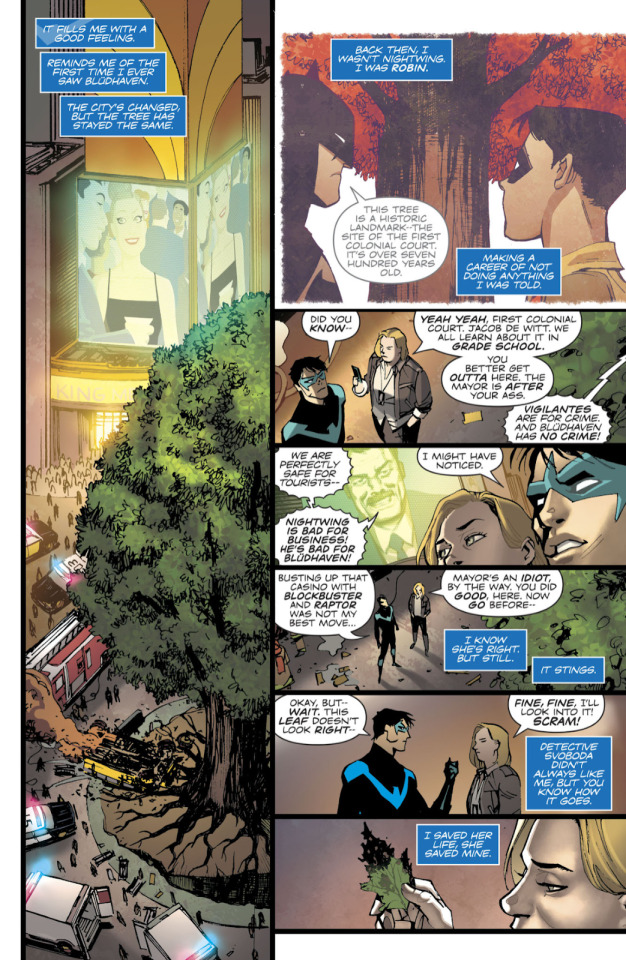
(Humphries, Sam, writer. Chang, Bernard, illustrator The Untouchable: Chapter One: Hunter. Nightwing: Rebirth no. 35, e-book ed. DC Comics, 2018. pp. 12)
In The Untouchable, the Justice Tree is rich with symbolism. First planted in Bludhaven by The Judge while he was still human, symbolizes, well, justice. As the Judge’s return and his machinations reveal the rot that had been seeping into Bludhaven, the tree begins to wither, its centuries old existence threatened. As the tree’s fate is at risk, so is Bludhaven’s.
The narrative goes back to the Just Tree just at the right beats, emphasizing the thematic core of its story. It also contributes to the plot by becoming a ticking clock. It’s threat countdowns to the big climax of the story, when Nightwing and the Judge will battle for Bludhaven’s soul. It is notable that while the Justice Tree was first planted by the Judge, it is Dick’s efforts that manage to save it, so even though both men are fighting for what they believe to be right, everything about narrative indicates that Dick is the one who ultimately has what it takes to save Bludhaven from corruption.
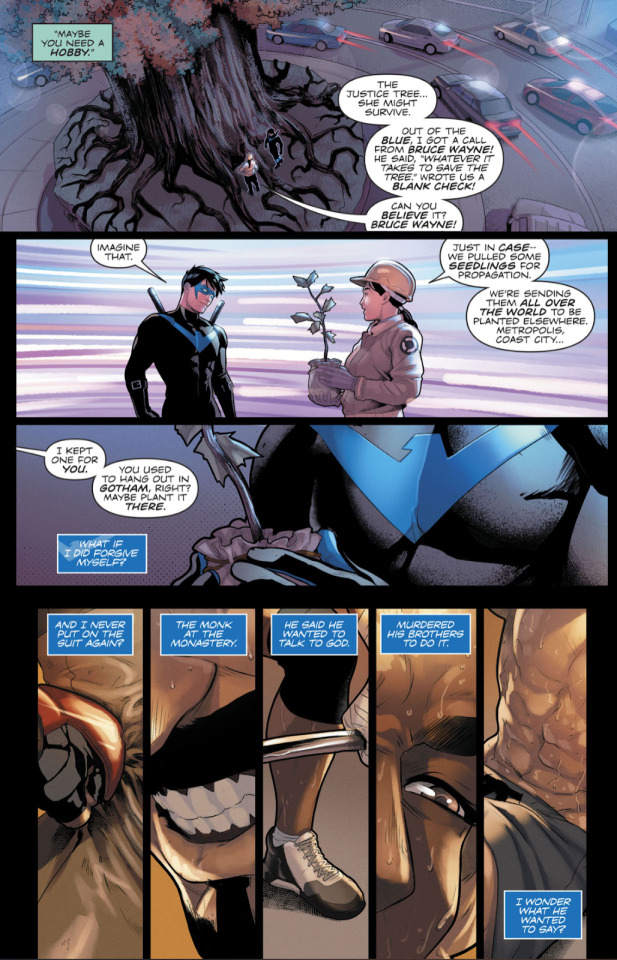
(Humphries, Sam, writer. Chang, Bernard; Campbell, Jamal, illustrator. The Untouchable: Chapter Seven: Final Judgment. Nightwing: Rebirth no. 41, e-book ed. DC Comics, 2018 pp. 22)
That being said, another big theme of this story is forgiveness and kindness, two principles that are essential to Nightwing. Dick emphasizes that no one should be judged by their actions when they are at their worst, so long as they decide to move forward and do good.

(Humphries, Sam, writer. Chang, Bernard; Campbell, Jamal, illustrator. The Untouchable: Chapter Seven: Final Judgment. Nightwing: Rebirth no. 41, e-book ed. DC Comics, 2018. pp. 21)
And yet, Dick is unable to extend this same kindness to himself. While he is able to forgive everyone around him for giving into the Judge’s temptations, he is unable to forgive himself for being unable to stop the Judge sooner.
These themes are embodied in the Justice Tree, which is threatened when the Judge is at large, and then is given a chance of salvation when he is captured by Dick and he is able to convince Bruce to invest in the efforts to keep the tree alive. The story concludes with Dick being given a piece of it to plant wherever he chooses (and he chooses close to his home, to Nightwing’s headquarter, the perfect marriage between Dick Grayson and Nightwing).
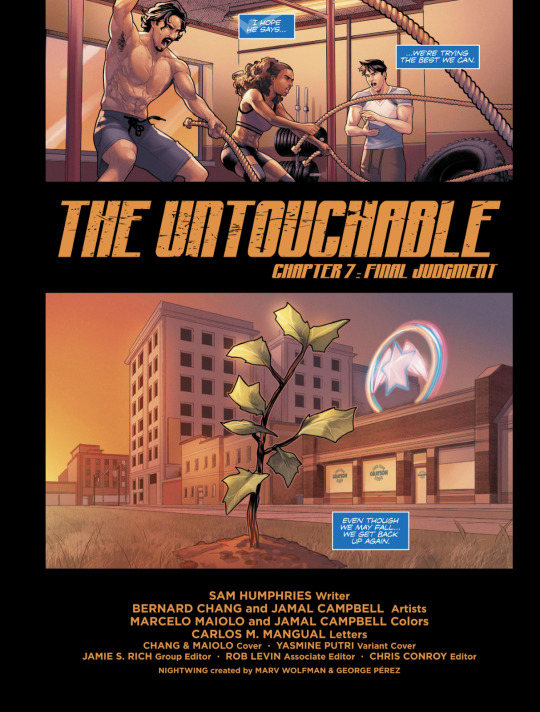
(Humphries, Sam, writer. Chang, Bernard; Campbell, Jamal, illustrator. The Untouchable: Chapter Seven: Final Judgment. Nightwing: Rebirth no. 41, e-book ed. DC Comics, 2018. pp. 23)
And that is not even to mention the way the art manages to convey so much. The tree that symbolizes justice is surrounded by the corrupt casinos. Nature is surrounded by artificial neon lights, circling in it, caging it so that it cannot branch out, cannot expand, cannot grow. The more natural, soothing colors of the tree contrasted against the bright neon colors of Bludhaven. The sharp lines of the tree vs the blurriness of the city. All of it visually conveys the main conflicts of the story that work together with its themes.
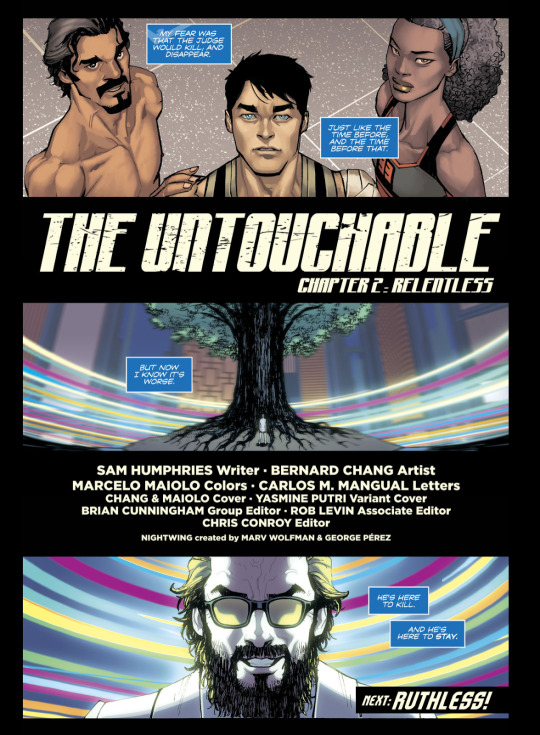
(Humphries, Sam, writer. Chang, Bernard, illustrator. The Untouchable: Chapter Two: Relentless. Nightwing: Rebirth no. 36, e-book ed. DC Comics, 2018. pp. 22)
By contrast, Taylor’s depiction of the Octopus Statue feels… Lacking. When looking at it with Babs, Dick ruminates on the history of Bludhaven and how it symbolizes Bludhaven’s resilience. He connects it to the city’s history and to how the people of Bludhaven can overcome even the most difficult challenges. In doing so, Dick also asserts his mission statement — he wants to be the safety net for these resilient people, he wants to be their protector, he wants to prop them up, to give them someone to rely on so they won’t feel abandoned.
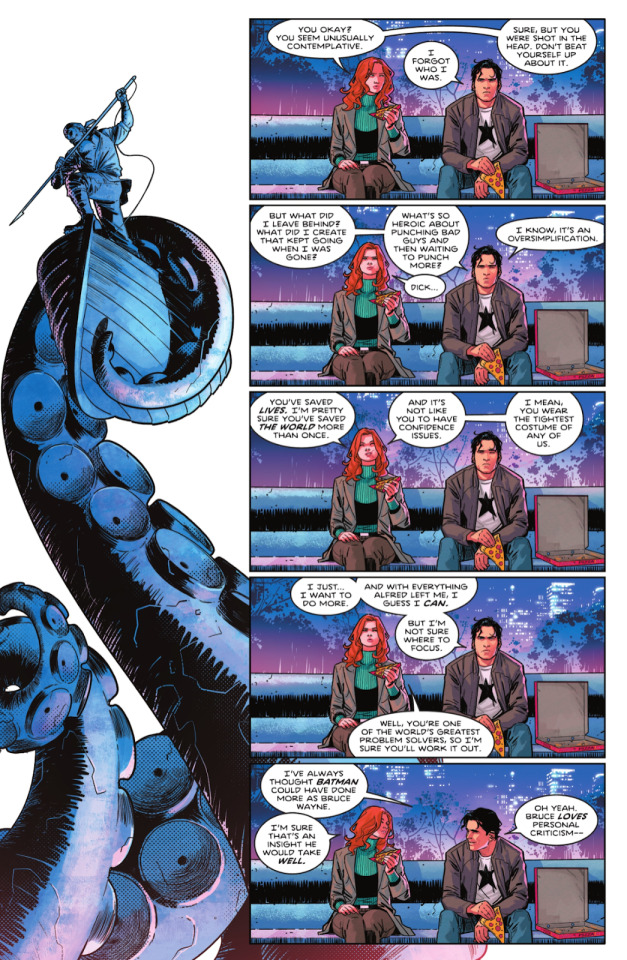
(Taylor, Tom, writer. Redondo, Taylor, illustrator. Leaping into the Light Part Two. Nightwing: Rebirth. 79, e-book ed. DC Comics, 2021. pp 07)
And yet, how many times do we come back to this one location that, in the beginning of Taylor’s run, was tied so strongly to Dick’s mission? How many times does Dick come to look at the statue? Dick is not given any crisis of faith because of the lack of conflict in the story, and yet, scenes in which he ponders whether he is going about his mission the right way while looking at this statue would have effectively shown the themes of the story and Dick’s inner struggles all while fleshing out Bludhaven.
Instead, Taylor readily abandons the statue just as soon as it is introduced. We don’t return to it, we don’t even use it as a set piece that can ground Bludhaven and make it feel like an actual place. It doesn’t make an appearance in any covers, nor in establishing shots. In fact, even its thematic symbolism is forgotten when Alfred’s statue is built. Such a decision is especially infuriating when one considers the fact that not only would Alfred hate having a statue in his honor, but that Alfred means absolutely nothing to the people of Bludhaven. He means something to the reader, but not the citizens of the city that Dick is meant to protect. In this, we see how once more Taylor’s online mindset interferes with his storytelling, replacing a set piece that was tied to the in-universe history of the city he was writing with fanservice.
(CONTINUE IN PART 2)
41 notes
·
View notes
Note
Omg I liked your response about book!Aegon and I’d like to add one point: the book is NEVER afraid to talk about rape and horrifying things that happen to women, but it NEVER explicitly says Aegon rapes anyone. That’s fascinating, don’t you think? Could just be a coincidence, but it’s a very interesting one. Not that groping people is better but there is an argument to be made for book!Aegon actually being a nicer-than-average guy as awful as that is since that makes him just a horny grabby drunk.
Thank you 😌
You think if it actually happened then it would be in the book as someone's account of the history, but even Rhaenyra's court jester Mushroom's unreliable accounts don't say that he outright attacks and overpowers women for his own pleasure. I'm not sure if book!Aegon is necessarily nicer than average, but I suppose that depends on what average we're talking about. Better than Daemon, who most certainly murdered his first wife, groomed his niece for his own political advantage, and had Laenor killed so he could marry her? Probably. Better than an everyday non-royal family man? Maybe not. But book!Aegon is definitely not a violent or sadistic Joffrey or Ramsey type of character that the writers want to suggest he is.
Of course, the writers would justify their decision to add new things to the show and portray Aegon in this specific way as the book purely being a "propaganda" account designed to prop up the Greens and put down Rhaenyra. This whole take doesn't make a lot of sense to me, though. Why does the book include accounts of both sides being terrible if their goal was to slander the Blacks only? You think if it was truly propaganda it would be more heavy-handed and favorable to the Greens than it is.
To me, their whole take of "what if it was all propaganda 🤯" is them thinking they're clever in their interpretation when actually they're undermining the underlying messages and themes of the story by messing with it so much. Additionally, the idea of the official history being written as propaganda and it being some conspiracy of the academics to portray the conflict differently than it actually was shows to me a lack of understanding of how academia and historians usually operate. There's just no way there would be the level of cooperation and coordination among so many different people to just rewrite and lie about history in this context. Not to mention showrunner Ryan Condal was talking about how stuff like the Blood and Cheese of the books was specifically made up by Alicent and relayed to the historians to be the worst possible version of events, basically saying that a lot of this propaganda against Team Black is an Alicent creation. Beyond the whole "not believing women's trauma" thing going on here... you'll see that Alicent never really had the power or access to give anyone any of this information or try to rewrite history. And at the same time, they're writing her as still in love with Rhaenyra and/or desiring reunion with her, so why would she be making up so much stuff against her? It just doesn't really hold up and seems to be more attempts by the writers to make Alicent into a villainous, hypocritical, hated character.
Aegon and Rhaenyra were both flawed in the books, and to be sure, not everything about either person was entirely true in Fire and Blood. But the show is out to make Aegon a degenerate, sadistic, cowardly, pathetic abuser eager for war and bloodshed and Rhaenyra a righteous, brave, just, level-headed savior who exhausted all options for peace before going to war to save the world from the "Song of Ice and Fire" prophecy... They want this story to be an oversimplified morality tale of good vs evil, so they insist that any accounts in the book that conflict with this interpretation are respective "propaganda" to make Aegon look better and Rhaenyra look worse.
Like, I get that Fire and Blood is written as a textbook, but you can't just so freely change the source material without it affecting the quality of the story being told. Imagine any other major adaptation insisting that their source material is false or fake and their version is what really happened. It would just make it obvious that they didn't understand the source material and were trying to justify their own questionable writing choices while at the same time rooting their own horn about how they think they're smarter than the original author.
16 notes
·
View notes
Note
OOOOH can I ask why u didn’t like polite society? I overall liked it but I def preferred We Are Lady Parts, also by Nida Manzoor, and ultimately had more nitpicky criticisms of PS than Lady Parts
yeah i feel the same way tbh and i'm wondering if it's bc polite society was a movie as opposed to a show so it didn't necessarily have the same amount of time to really develop its plot points or characters? but i feel like what ultimately bothered me is it was sort of a movie about ria at lena's expense. like aside from that initial scene about lena trying to make art, she was never really afforded personhood outside of the immediate arranged marriage plot and ria largely facilitated that. which i think the movie tried to critique obv but i don't think it accomplished that effectively bc ria was sort of conveniently excused of being held accountable for her obscurity of and projection onto her sister bc she was right about raheela's secret plan all along. so it ended up being less a movie about sisterhood and more a movie about.. ria was right the whole time and ofc raheela was evil and now everyone is happy the end? which is oversimplifying it a bit but that's how i came away from the movie feeling, like i knew absolutely nothing about lena other than that she wanted to do art once, dropped out of art school, thought she wasn't good enough, done. she was never really afforded the same amount of detail or introspection that ria was and resultantly felt like less of a character and more of a prop. i also understand the raheela plot was largely satirical exaggeration but i feel like when juxtaposed against the sister conflict it was very.. awkward? like comparatively in we are lady parts even though there's moments of ridiculousness and exaggeration it does ultimately maintain a realistic tone. and this movie felt like it was split in trying to tackle realism and absurdity at the same time and it didn't mix well for me at all in the end.. like i hate to make this comparison bc frankly i'm not a fan of this movie eitherjklgjdfhkfg but in greta gerwig's little women at least if there was a plot about jo fearing losing her sisters to marriage it was balanced out by the fact that those sisters actually had lives and personhoods and dreams that were shown in full measure. but like i already said lena didn't really get her own perspective in this movie and so it felt more like ria was angry about losing someone to arranged marriage than she was angry about losing her sister. like does that make sense? bc obv within pakistani society the practice and threat of arranged marriage is a very real one and ofc there's a worthwhile story to explore in a younger sister fearing her older sister will lose out on her dreams and aspirations if she opts for marriage out of a sense of failure and depression. but the way that arranged marriage was just so absurdly and cartoonishly portrayed kinda undermined the whole thing for me bc it felt less like ria was saving her sister from a societal institution and more like she was saving her from a random evil cartoon villain
and i think that in turn kinda veers into how most of the characters in this movie generally felt very, very generic. not only when it comes to motivations and archetypes but frankly also culture. like i couldn't really tell what anyone was beyond a generic south asian. culture was such a minimal part of the picture beyond the negative parts of it the movie chose to focus on and i simply find that unbelievable like even the most burger and liberalized pakis i know are entrenched in being paki. and i know that's an unfair assumption to make of any diaspora paki like i'm sure many are not entrenched in culture but it's about the little things yknow? like trinkets around the house, or family pastimes, or little endearments, or trips to paki desi stores. this movie felt so removed from that semblance of the everyday. like it could've been about any group of asians really. and that's a bit ironic too bc despite being a movie about pakis most of the cast were actually indian. which to be clear i'm not someone who gets up in arms about nationalist identity etc like that's dumb and frankly we should never have been separated into two countries. but i think if you're making a movie about paki muslims then they should sound like paki muslims, no? every butchering of terms was not a knife to my chest per se but it was certainly annoying. and i also found it ridiculously hard to believe that even the most posh paki auntie would show up to her son's wedding wearing whatever that atrocity nimra bucha had on was. like even gaudy women dress culturallyglkfjhfg. idk. maybe it's me being too nitpicky but i feel like it's something that bothered me more here than the removal from culture in we are lady parts bc that is precisely the point in the latter: cultural isolation from community. we are lady parts just seemed to go so much deeper into the themes it was trying to explore and i feel like polite society never really broke surface level
#outbox#sorry omg that's so much.. i feel so mean being critical of diaspora media bc it's like!#obv some of this is coming from experience!#but idk i think when you're criticizing your culture it's very easy to fall back on caricature as opposed to substance#and that's what it felt like here#maybe that's something i esp felt bc i've been so entrenched in desi dramas recently and the difference in nuance is. utterly staggering#like maybe it's a personal preference but i want to see abusive and exploitative mothers that feel real and not like cartoons#bc that's what they are. they're not evil for no reason. there's reams of trauma and cycles behind all of it
8 notes
·
View notes
Text
I decided ahead of time not to watch season 4 of the Boys.
I was recently vindicated in this decision:

So a main character's sexual assault at the hands of a villain, where he is clearly feeling a lot of intense emotions, going on for a brutal length of time onscreen, is meant to be comedic.
Keeping this in mind, I think the show has earned enough bad faith that I can happily talk shit about some of it.
Like, not all of it. There were reasons I watched all the way through season 3! Lots of good character work, great action, some effective deconstruction of celebrity culture and the corporate/political machine behind it.
But there are a lot of cracks that really started to show and led to me jumping ship.
The women in the show keep on getting defined relative to the male characters. At first it seems like it's women portrayed trying to exist relative to a toxic masculine environment but it really seems more than that: Becca, once she's saved and allowed to be a character for a bit beyond a man's tragic backstory, is shortly fridged. A-Train kills his girlfriend and that is just fuel for his character development. Starlight, Kimiko, and Stormfront are mostly defined by their relationships with their male partners. The Deep is given way, way too much focus, turning him into a recurring comedic relief sort of character, which, even if the joke is he's so pathetic, is still treating a man who raped one of the main characters for laughs and giving his story way too much priority and screentime that just wasn't needed.
This is related to a lot of really crass and fucked up black humor being used way too casually on the whole. It was in service of poking fun at the very clean depictions of violence that the superhero genre and the media machine would prefer, and so I had some good faith towards this. But in light of the above comments, that good faith is highly depleted.
The show's other big flaw is that it keeps undermining its own stance against fascism, which was really conspicuous in season 3. It clearly outlines that attempts to reform the corrupt system will ultimately be subverted and co-opted by the system, and peaceful means of rebellion can simply be ignored by a powerful and indifferent regime with a monopoly on force. However, all violent means of dealing with the oppressive regime are subverted, with the show portraying the violence the Boys engage in as fundamentally corrosive to them, and all meaningful plans to take against Vought having unacceptable collateral damage. Depicting problems with violent rebellion is good, but by the end of season 3, all action we are signaled to be rooting for is in favor of the oppressive status quo: Homelander shouldn't be killed, Vought shouldn't be wrecked, people need to stand down, etc. The fact that the Boys are government agents with little accountability furthers the theme of toxic masculinity saturating the violence, but also takes the teeth out of its ability to criticize its fascist villains. This is a show ostensibly about fighting the evil superheroes that are embodiments of the worst excesses of humanity, starring a government black ops team with their own excesses, that chickens out of fighting the evil superheroes, made by a company that epitomizes excess, and run by a man who thinks sexual assault is funny.
There are good parts to the show, I'm sure there will continue to be good parts to the show, the show has been an important contribution to the conversations surrounding the superhero genre. But I am comfortable in saying that it is simply not worth my time.
1 note
·
View note
Note
I really don’t get why people keep saying Allura was SO awful or horrible to Keith after learning about his heritage. She just gave him the cold shoulder for an episode or two, and it’s not like they brought this up later in the show as a way for her to hold some other grudge against him. People are just blowing it up as something bigger than it actually was. And like many people have said, her liking or “suddenly” being nice to Lotor wasn’t bc oH he’s Altean (1/2)
Continued anon message: “There were several moments between their first close encounter and him revealing his heritage which prove that trust was developing before then, but I guess people just overlook those (2/2)”
Hi, anon! Thanks for the note! Yeah, haha, this topic of “is Allura racist?” is an interesting one because for me, it boils down to looking at the show’s design decisions and details. And those design decisions came from real human beings who aren’t any more objective than the rest of us. So as a content creator myself (who feels incredibly human and and whose stories and portrayals are also imperfect by virtue of their imperfect creator), I have to recognize that it’s impossible to create a totally woke, unproblematic creative product—and it’s also impossible to ensure that everyone around the world interprets everything in exactly the same way, no matter how well-intentioned the project.
That said, I do think a lot of fans are victims of how this show may have manipulated/gaslit them to feel, not just about Allura but also about other characters and events as well—and that there are benefits to analyzing what went wrong with VLD.
My hope is that, as content creators and fans, maybe we can learn from VLD’s narrative mistakes or even better understand how two fans can have totally opposing interpretations over the same creative work. In the case of VLD, as I’ve mentioned before, the show uses a screwy and imbalanced narrative lens when portraying victims. To add to that, the show design also consistently undermines details foundational to the show universe (such as using an unreliable narrator to express what the show actually accepts as objective fact or history). This is important, because the way in which something is told/shown ultimately manipulates audience emotion for or against something. This gets into how propaganda and subliminal messaging work at a technical level. And when the narrative lens is handled in a biased way that undermines other story elements, audience reaction/interpretation gets messy, no matter what the stated events/facts are in the story. We are attuned to pick up on cognitive dissonances (inconsistent patterns) as part of our human survival instinct.
I’m not convinced that VLD dev team wielded the Power of the Narrative Lens very well—if it had, season 2′s portrayal of the conflict with Keith and Allura would have looked different.
In an s2 with a more balanced narrative lens, we likely would have seen at least flashes of Allura’s memory, showing some s3 backstory of Allura’s fear upon realizing that previously faithful Galran allies were killing multiple civilizations upon an order from their own kind...and coming for Altea next. Or maybe there would have been something/someone else involving Allura’s traumatic experiences so that the audience could have an empathetic, emotionally connective moment with her. We would have, in equal parts, still seen Keith’s plight as the suffering saint trying to figure out what being half-Galra means. And we would have seen the other paladins trying to resolve the conflict and understand how to recalibrate together as a team and a family.
Instead, in provided canon, we see Hunk (of all people, why Hunk?) make racist microaggressions at Keith, further alienating Keith without any recourse. And for Allura, the visual lens shows her making a cold glare at Keith without further explanation. It’s a very alienating moment. In season 2, you feel that coldness from Allura because the show’s visual lens aligns you to Keith’s gaze for several agonizing seconds, and the narrative bias of the animation is to show Keith as the singular victim in this situation. It is a very targeted, lonely, and disquieting moment for Keith. The other paladins and their reactions to Allura and Keith even feed into this. It’s not until s3 that we get an emotional glimpse into the omnicide of an entire solar system—and even then, that history focuses more on the motives of the instigators rather than showing the brutality experienced by victims. By that point, we’ve blown way past the s2 issue, which creates another layer of cognitive dissonance: that the situation doesn’t feel totally...resolved, somehow, even though plot-wise it actually is.
So I think there are indicators that the dev team’s own biases and agendas informed, at times for the worse, the very lens through which we consume the VLD story. I don’t think the dev team was aware what tackling genocide while visually portraying Allura’s trauma as antagonistic and alienating would result in? And I think this oversight gets into why some fans feel a certain way about literally anything in this show, haha. So I feel like we’re all victims of a show with amazing potential and incredibly fascinating elements but just…poor execution.
One other thing I have to give faith on when I have a disagreement with another show fan—it’s a 78-episode show. How often are people holistically watching and critically reviewing this show in order to catch every little detail? I’m pretty sure I can’t remember all the details either, even though I re-watched the show not that long ago. So there’s a whole other layer here, where fans have a separation from the source content itself. So take those emotional negative “impressions” people developed while watching s2 or any other moment where Allura has been less than the ideal woman (oof, fandom is so forgiving with men but so unforgiving with women), and then suddenly muddy those memories with 2 years of not re-watching the show holistically. Typically, the brain is better at storing negative reactions than positive ones. So if someone had a negative reaction to Allura’s actions with Keith in s2 or elsewhere, without an empathetic moment to balance it out, then that negativity is going to stick, and every detail to the contrary is going to fade out.
I know for me, I’ve really had to fight the memory problem because after over a year, for example, I was building up impressions about VLD history that actually were missing some important details from s3. And that was kind of a shock to me. So I do think selective memory plays a part in adding to a biased dissonance one might feel from the actual story.
Ultimately, this whole unnecessary fandom split on “is Allura racist?” is one reason why I feel that VLD—for all of its good things that I genuinely love so much—had a lot of troubling issues. Despite all the canonical good that Allura ends up doing and how she overcomes trauma to champion genuine peace for all, there’s subliminal messaging against her because of how the visual and narrative spins or hides things. And that issue has nothing to do with the characters but everything to do with the development team and how the show was written/directed. And that, I think, informs ongoing fandom perceptions of Allura and creates just some really painful and unnecessary messes, to the point of creating an overall inaccurate take like “Allura is racist” when in fact, she’s just traumatized from very real and significant abuses and overcomes that, even.
It really makes me, as a writer, try to look at my own stories and attempt to understand “why” I portray certain things as I do while writing—and if that lens portrayal is really the best one for the effect/message I want. Because the way in which a story is conveyed can really play mind games with the audience, and that might not be the right effect for a story that isn’t another Inception or Crying of Lot 49, lol.
#Voltron#Allura#Keith#VLD#Writing Techniques#Subliminal Messages#Biases in the Visual Lens of a Story#VLD had an incredible lack of empathy for victims#it shows in the very way it portrays their stories and then villainizes or undermines them#Thanks for the note anon!
12 notes
·
View notes
Note
For anon from post this post https://www.tumblr.com/olderthannetfic/696312790458236928/its-generally-pretty-hard-for-me-to-feel-guilty?source=share
yeah I get it! I'm a big fan of a few police procedurals and I can usually suspend my disbelief regarding the positive portrayal of police or the way characters are portrayed positively while they casually violate the rights of suspects. I regulate it to the same space in my brain that knows things like monarchies suck but still enjoys shows like Merlin.
But then sometimes it gets so blatant I just... can't. And unlike the fantasy monarchy, cop stuff hits a lot closer to home! It's frustrating and annoying from a "that's not how that works" standpoint, but it also makes me feel awkward and guilty in the moment for enjoying it because suddenly you get hit with the realization the writers and many of the viewers probably don't think this is a break from reality to make things more exciting or narratively appealing, but stems from their IRL values and views. I'm usually in it for the character relationships or the murder mystery elements, so suddenly getting hit by an anti-drug diatribe, police brutality or ableist narrative elements is upsetting to say the least. And it helps if you're more into the character relationship elements of the fandom since they tend to brush over the police aspect or use it as background for character dynamic stuff, but if you're into more plot-heavy stuff, fanfiction can be uncomfortably unquestioning about it at best. But then I can't blame fanfic writers for not turning every fic into a deconstruction of the genre because I don't do that either, that's often not the point of whatever I'm writing even if my RL views on police might feed into how I characterize things.
Basically there's no right answer I guess. If there were more murder mystery + buddy dynamic shows out there that didn't feature police that'd be nice, but even then it would probably still feature problematic elements regarding the nature of crime and punishment as well as catching murderers while grossly violating their rights because that's more exciting the procedure and paperwork. Hell, I often finds attempts by many police procedural shows to tackle real world problems with the police even worse than ignoring them, if only because they can't actually go further than "Bad Cops Exist, But So Do Good Cops" without undermining their core premise. James Bond, to not fall into that Western interventionism is good message, would have to get complicated and uncomfortable and lose the moral simplicity that played a part in making it popular. You could write fic about James Bond learning his own government is equally corrupt and going rogue but... the very core of the spy genre is based on the protagonist sticking their nose in the affairs of another country. Or deconstruct the spy genre, except that might get dark and upsetting if you really want to get into the issues of interventionism. Or make your spy protagonist serve another, traditionally colonized country, except that country will also have its own skeletons that will need to be brushed past. But also... that might be less fun. It might not be why you enjoy James Bond.
Even making your protagonist fight Nazis can feed into some "we weren't prejudiced and played no role in the Holocaust and fighting Germany was a total hero moment" narratives regarding the complicity and subsequent many countries had in anti-Semitism even if they were on the side of the Allies (plus the war crimes), as well as treating Nazis as cartoon villains resulting in making it hard for people to identify Nazis in the real world because they're also human beings. The base premise of a lot of emotionally appealing and exciting stories are often inherently problematic for the very reasons we like them. Sometimes is fun when the orcs are just evil and we don't have to grapple with the morality of our protagonists killing them. Sometimes its fun when the horrors of war comes second to the coolness of explosions and giant tanks. And stories that deconstruct and challenge these premises are important of course, and we should question the prevalence and themes in many of these stories, but playing them straight on occasion isn't responsible for the foreign policy of first world countries nor is it the sole culprit of why people think police are trustworthy and should carry guns. I mean, I almost wish it was, that'd be a lot easier to change, but I feel like while me enjoying copaganda shows and fanfiction makes me complicit in some ways it does so in the same way buying imported food at a grocery store instead of going to the local farmer's market makes me complicit in factory farming and neo-colonialism and climate change.
--
39 notes
·
View notes
Text
And also on the topic of Rich Burlew’s thoughts about villains and things they inspire me to talk about, we have this statement on the Cool Bad Guy trope and Tarquin:
I'm not complaining that they love the villain as a character, I'm complaining that they love the villain as a person. I want them to love Tarquin as a well-developed element of the fiction that serves his purpose in the story well while raising interesting points about both the way people act in the real world and the way that stories are often constructed these days, and gets off some funny jokes in the process. I don't want them to love him because it's so cool that he can do all these horrible things and still be totally emotionally untouched by it because yeah, doin' evil is awesome and totally should be portrayed as just another lifestyle choice!
And I wasn't really complaining so much as saying I have no interest in making that easy for them. It undercuts the point I am trying to make, which is that evil isn't cool. Which is challenging the traditional narrative—at least the narrative of the last 40 years of pop culture which has told us relentlessly that the character who is more morally questionable is always cooler than the one who is more morally upright.
The above quote unfailingly makes me think of Spike from Buffy the Vampire Slayer.
Spike is a really fascinating villain for many reasons, one of those being the fact that he, like Tarquin, ends up being a deconstruction of the ‘Cool Bad Guy’ trope. In Tarquin’s case, Rich Burlew appears to have written him very intentionally to fulfill that role, systematically building him up and then tearing him down. With Spike, it was more of an accident – I recall seeing an interview with James Marsters where he basically described how his original function on Buffy was supposed to be, loosely: show up, be really cool, then die. The fact that the character ended up being so popular the fans wanted him to stick around led the writers to keep him on, but they ended up taking him in a whole new direction (because being ‘the Cool Bad Guy’ was presumably too shallow for a recurring character?). Spike’s subsequent development ended up dismantling the notion that he was ever genuinely cool in the first place, arguably undermining the notion of the Cool Bad Guy in the process, and I could honestly ramble for ages about this. Spike is fascinating to me both as a prime example of why the Cool Villain trope can be so appealing in itself, but even more so as he gradually subverts all of that.
#rich burlew#spike#tarquin#btvs#buffy the vampire slayer#cool bad guys#villains#villains discourse#oots#one day i will get round to writing this#tarquin and spike are both amazing characters
47 notes
·
View notes
Text
MVA is a Matryoshka Doll of Character Development & Framing: Yes This is About How the Anime Failed. Whatever.
Breaking it down, the My Villain Academia arc serves two (2) main purposes in the overall narrative.
→ Put the League of Villains back in a position where they can be a credible threat to the heroes after losing All for One and their potential partnership with Overhaul falling through. Obviously accomplished by upgrading Shigaraki / Twice / Toga, giving Shigaraki the Meta Liberation Army, Ujiko’s assistance, Gigantomachia’s loyalty, etc.
Of course the anime undercuts all of this by letting the heroes know what the League is planning before the League can take advantage of their new position (ergo narratively giving heroes the advantage, as seen in the manga’s war arc) before we even get to see HOW they got all these cool new toys. So why bother. That’s a different sin that the anime has committed, we can put this on the backburner.
→ Pseudo-reboot the direction of the story so that villains are characters on equal standing with the heroes, rather than being obstacles to beat up. This involves a lot more factors, but it’s all rooted in how the arc and characters are framed, and how the characters are developed.
I talked a bit about my concern about the sympathetic framing of the League in MVA way back when we first learned about the anime arcs being shuffle here (my triumph of objectivity). The gist of it is that the arc switch undermines the way the League are portrayed as underdogs—broke, aimless, and relatively weak compared to the heroes and the army coming for their heads—and I was right! Worse, they didn’t just undermine that underdog framing, they straight up didn’t bother. There is zero context for the League’s situation post-Overhaul, pre-Gigantomachia. No explanation for how they have to rob other villain groups to get by, that their equipment is breaking down, that they have no solid end goal or means to achieve anything of note. Just a challenge from Ujiko and Gigantomachia that loses a lot of pressure without understanding the sorry situation the League is in.
Tellingly, they don’t even let the League kill the fantasy racists. Who doesn’t want to see the fantasy racists get murdered! Outside of the existence of the CRC being an interesting bit of worldbuilding that confirmed the existence of heteromorphic discrimination, which is likely to continue playing a role in the manga, it’s an easy way to let the villains be villains while allowing the readers to go with the flow into this villain-focused arc, without having to be outraged by their actions.
From the get go, we’ve lost the framing that made MVA an arc worth paying attention to when it was first released, which indicates a) that the anime doesn’t care about the actual purpose of this arc outside of setting up a flashy hero vs. villain fight for season six and b) that we shouldn’t expect much from the rest of the anime arc. Even if they get the technical aspects of it right, we’ve already lost the weight of the narrative.
MVA is also obviously known as being the big push to develop the villains as characters. We’ve gotten some character development for them before (Twice and Toga’s adventures with Overhaul, Shigaraki’s consistent growth from “brat” to a capable villain and leader in his own right), but MVA is the first arc solely dedicated to their stories and humanization. However, there are “tiers” of character development and focus here, nested within each other, that are tied into the arc’s narrative structure.
Getting them out of the way: Dabi and Compress didn’t get to do much, though we do get to see their relationships with the League in action, plus stuff like Dabi’s quirk limits which come up later. Otherwise, their actual storylines only come into fruition or start with the PLF Raid arc (which in itself is dependent on MVA but that’s another argument).
More memorable and meaty is the development for Toga and Twice. We learn more about their backstories, we get to see them push themselves to the breaking point for the sake of survival, Toga gets to evolve her quirk while Twice finally uses his to its full potential. We also get to understand their personal philosophies, relationships with society, how they view the world around them, and their loyalty to Shigaraki and the League. And with the manga’s underdog framing and the life-threatening situations they were thrust into (plus at the time they didn’t have guaranteed plot armour the way the students and heroes did), the audience wants to root for them, even if they’re the bad guys!
Toga and Twice’s development are undeniable highlights of the arc, contribute strongly to the story as a whole, and justifiably receive a lot of attention. However, they are also primarily moments nested within the arc, tying into their personal ongoing storylines (Twice’s starting with the Overhaul arc and ending tragically with the PLF Raid; Toga’s storyline carries on into the PLF Raid with the loss of Twice and her confrontation with Uraraka). But they aren’t the primary storylines of the arc.
A primary storyline of MVA is in Shigaraki being able to identify the direction he wants to take the League in and make that a reality, as well as answering the questions of his past. MVA starts with the League’s aimlessness and with him revealing how little he remembers of his origins; the arc climaxes with him regaining his memories and having the confidence and strength to earn the Ujiko, Gigantomachia, and Redestro’s loyalty and resources, giving him the means to finally enact his dreams of destroying hero society. Toga and Twice’s development is encased within Shigaraki’s storyline, and that storyline provides a concisive beginning and endpoint structure of My Villain Academia—
Except Shigaraki’s narrative structure is encompassed by a layer even beyond that: Spinner’s story. When the arc begins, before Shigaraki can discuss his dream of a destroyed horizon, Spinner is the one challenging him about the League’s lack of direction and purpose. When the arc ends and Shigaraki stands victorious, Spinner is the witness who now understands that the destroyed horizon can be their reality. Spinner is the one watching Shigaraki throughout the arc, Spinner’s gaze is emphasized at the beginning and end of Shigaraki’s MVA storyline, and Spinner is the one who undergoes the most radical change from frustrated Stain flunky to Shigaraki’s devoted follower.
To paraphrase from @stillness-in-green, My Villain Academia is “about what Shigaraki coming into his own looks like to the people watching him”. To Re-Destro, to Ujiko and Machia, and most importantly to Spinner.
It’s been frustrating enough over the past two years to see people who have read the manga discard Spinner’s role in the arc just because he isn’t a basic easy pretty boy didn’t get an elaborate flashback sequence the same way that Toga, Twice, and Shigaraki did. Seeing the anime not even bother emphasizes that lack of comprehension. But why does it specifically matter that the anime screwed over the Spinner & Shigaraki premise of MVA?
Aside from the anime’s decisions taking all the weight out of the story: In the current manga, Spinner is the only one left at Shigaraki’s side who is specifically loyal to and cares for him.
Barring executive meddling, Horikoshi changing his mind on plot points that he set up, and straight up bad writing (which can all very well happen): You don’t go through the effort of developing a character like Spinner, explicitly in conjunction with your main villain, as the framing perspective of an arc that is so vital to your story, without having a plan for that character. With the way Spinner is positioned right now, there’s a lot that can be done with him! And if that potential does get utilized, then the anime lost out their chance to give that potential its due.
Between the immediate loss of set up and context, tossing the pseudo-protagonist framing of the League, and gutting the emotional core of Spinner’s developing regard for Shigaraki, the anime adaptation has already lost. The rest of the episodes could be perfectly competent, but without the actual base of the arc it all falls flat. Hell, they could stick Spinner’s confrontation with Shigaraki in as a flashback in his fight against Trumpet and it won’t matter; that just nests Spinner’s story within Shigaraki’s the same way Toga and Twice’s is, when it should be the other way around.
Of course there are other reasons why MVA anime arc is set up to fail without reany spect for the source material (I know that the MLA got screwed over in the PLF Raid arc but that’s no reason to not even TRY with introducing them into the show properly just LET Rikiya be his fun, threatening, and engaging self!), but the fact of the matter is that I’m not going to get my Spinaraki AMVs and I want to fucking die about it.
#a lot of this has been said but people are still JUST off the mark of why exactly losing spinner's scenes is Bad#bnha#bnha bloggin#bnha spoilers ?#spinner#shuichi iguchi#mva wank
75 notes
·
View notes
Note
Disregard my last ask because the latest issue raised a troubling question that I, as a black man, feel the need to clarify with you, a woman. That whole whole Ned Leeds/Betty Brant business is sexual assault via deception right? Like you know more about Clones and Spider-Man 616 than I but I feel like that’s besides the point because it happened to Betty. She is carrying the child of whom she thought was her dead ex-husband. And Ned clone has to know he is a clone. He has to know. Unlike Ben and Kaine, he has the awareness and information of the Jackal and the awareness of his progenitor’s death.
Or am I reaching too far and reading too far into things?
I'm glad you came back and asked this specific question because it's definitely something I have a lot of thoughts on, and I’m glad you asked my thoughts on it as a woman because I think this is one of those comic book storylines that’s hard for me to divorce that fact from -- the fact that I’m a woman definitely plays into how I view this storyline specifically and how it effects me, in ways I don’t think were necessarily intended by some of the writers involved in its ongoing arc who were not looking at things from the same perspective I’m coming at them from. I definitely don't think you're reaching or reading too far into things -- I think that is what's being presented on the page, albeit likely without authorial intent. Just as like a general disclaimer, I'm not closely following Spencer's run for the sheer reason that I'm not enjoying it very much, although I'm aware of the general directions it's taking through friends and social media. But I actually think this Betty/Ned issue goes back pretty far.
First things first, I think Clone Conspiracy really wreaked havoc on how Spider-Man as a series has always handled clones. Pre-Clone Conspiracy, there was a very clear clone narrative going on: clones are their own person, they are not direct copies or replacements of the original. You see this with Ben Reilly and you see it with the Gwen Stacy clones. Clones are treated as their own individuals, even if they have to struggle to get to that point -- there's even an issue of Spider-Man Unlimited where Ben and Betty go on a date. Betty doesn't know that Ben is Peter's clone -- he's introduced as his cousin -- and they both reflect on how you can't go back to the way things were. So even though Ben has all of Peter's memories regarding his initial romance with Betty, the narrative makes it clear that Ben and Betty cannot recapture that connection or that exact relationship.
Here's where Clone Conspiracy changed everything, in my opinion for the worse: Clone Conspiracy's clone narrative is that these clones are, essentially, the original person. I believe the Marvel wiki still actually lists the end of Clone Conspiracy as 616 Gwen Stacy's issue of death instead of Amazing Spider-Man #121, because Clone Conspiracy treated that Gwen not simply as a clone with all of the same memories, but as essentially Gwen resurrected through a cloning process. The Billy Connors who was cloned is treated as the same Billy Connors who was killed by his father in Shed (Amazing Spider-Man #630-633). And the clone Ned is treated as the same as 616 Ned. This is a mess, to put it simply, because it goes against all the previous Spider-Man cloning narratives and, honestly, most popular sci-fi clone narratives, and it's seriously undermining decades of good Spider-Man storytelling in ways that Slott didn't address and that Spencer seems unwilling to. It probably wouldn't have been a very big deal -- a frustrating one, but not a big one -- if all of the clones had perished at the end of Clone Conspiracy, but they didn't. Billy Connors escaped, and it's immensely frustrating to me to see Peter treating the Connors family reunion as something he can tolerate when Curt Connors ate his kid, and the Ned clone slithered away in the gutters to, I assume, spite me personally.
Which brings us to the current Betty Brant storyline in Amazing Spider-Man, where Betty has showed up heavily pregnant and informed Peter that the child is Ned's.

Yeah, I would say this is in fact the worst possible part. (ASM (2018) #67) Just speaking for myself, I'm generally not anti-pregnancy or baby storylines in comics, but this one is making me very uncomfortable for reasons beside Spencer being apparently unable to find any way to fit Betty into his stories without her showing pregnant.
So I'm actually going to take this back way, way to when Betty and Ned first got married, with some explanation of who Ned Leeds is for the uninformed, because, especially with the MCU's Ned Leeds in the mix, he's not exactly the world's most well known Spider-Man character. (I’m sure @ubernegro, who is much more well read on Miles Morales’ canon than I am, has thoughts on how the MCU’s Ned borrowed heavily off the character of Ganke Lee with a 616 Peter Parker character’s name pasted over him.) Ned was initially introduced as Peter's competition for Betty's affections -- Ned was older than both Peter and Betty, a working reporter, and presented as the more "stable" option compared to Peter, who of course Betty vastly preferred before circumstances tore them apart. Ned and Betty married in Amazing Spider-Man #156 and jetsetted off to Europe for Ned's job. This is where the cracks in the marriage began. Betty later reveals that she felt abandoned by Ned in Europe, to the point where she was able to come back to New York without his immediate notice -- as a woman, it's very easy to read their relationship at this point as being one filled with, if not abuse, then emotional neglect. Betty and Peter have a quick extramarital affair at this point -- Peter has just broken up with Mary Jane and Betty claims she and Ned are separating -- that persists until Ned returns and punches Peter over it.
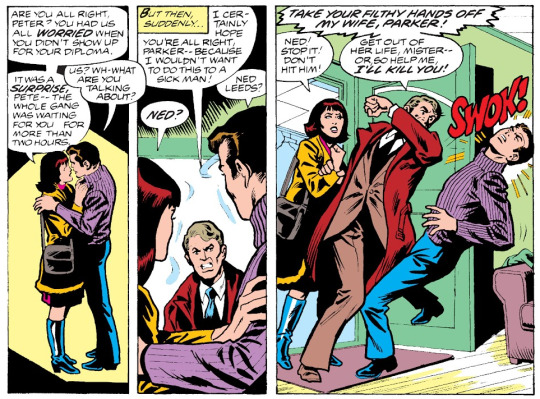
(ASM #193)
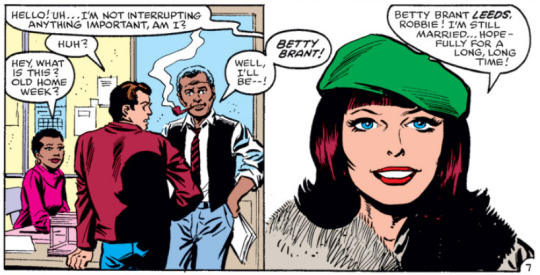
(ASM #229) Betty and Ned reconcile off panel shortly thereafter, but that's pretty far from the end of the story. It's implied that the problems Betty and Ned previously had start to develop again, namely that Betty feels abandoned by Ned, that he is inattentive and, again, as a woman, it's hard not to read it as emotional neglect, if not abuse -- yet. Betty does start another affair at this point, this time with Flash Thompson, and Ned starts acting strangely. It would later be retconned that he was suffering the effects of hypnotism by the Hobgoblin, but like I said, that's a retcon, and what was happening at the time was that Ned was acting erratically in part because he was the villainous Hobgoblin. Ned becomes controlling, threatening, and verbally and physically abusive towards Betty.

(ASM #284)
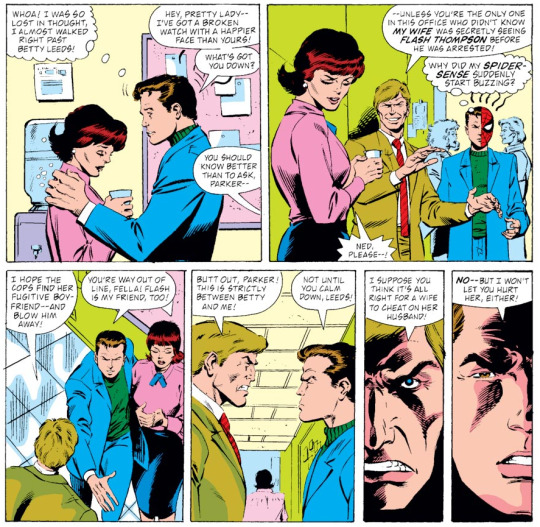
(ASM #283) "I suppose you think it's all right for a wife to cheat on her husband!" "No -- but I won't let you hurt her, either." Leaving aside that Peter also had an affair with Betty, something he's conveniently forgetting in the above panels, I've always really liked this exchange, because the narrative makes it clear through Peter's response to Ned that, whatever the audience may think of Betty for cheating on Ned, it is reprehensible for Ned to publicly humiliate her and/or physically abuse her as a response.
Then Ned Leeds dies in Spider-Man vs Wolverine and he's revealed as the Hobgoblin posthumously shortly thereafter and that remains canon for years and years until it's later retconned out, as comics are wont to do. But that's not really that important for this conversation -- my point being, at one point in Spider-Man canon, it's made fairly clear to the reader that Ned is an abusive husband. He emotionally neglected and abused Betty several times over and physically hurt her at least once on panel, with the clear intent that the reader should realize that he is physically hurting her. So for me as a reader and as a woman, this has always been a really uncomfortable relationship. I have a problem with later Spider-Man comics claiming that it's "not Ned's fault" that he abused Betty because of the retcon that he was hypnotized, and I have a problem with the MCU making Betty and Ned into a cute summer fling in Spider-Man: Far From Home, because I feel like Ned's clear abuse of Betty either gets excused or entirely glossed over. And I don’t think the initial abuse storyline is bad -- I think there’s some amount of value in portraying Betty as a woman who marries too young, who experiences a terrible marriage, and who then spends years recovering from that marriage, which was the case up until they retconned Ned’s abuse of her as a side effect of him being controlled by the real Hobgoblin. What I’m specifically uncomfortable with is the post-retcon attitude that since Ned didn’t really mean to abuse Betty, it’s perfectly fine to portray the relationship in a positive light when even before Ned’s abuse became physical that wasn’t the case. I think that’s ultimately really irresponsible storytelling. As a reader, I’m not against soap opera style storylines -- someone getting impregnated by a cone of their ex-husband seems pretty par for the course. But there’s so much additional context here that I still haven’t entirely processed how I feel about this Betty storyline, except that what I feel isn’t positive.
So yes, I would agree with you when I say I think there’s quite a lot of deception involved in Betty’s pregnancy storyline -- the Ned clone didn’t tell her he was a clone, even though he had full knowledge of that fact, just as he had full knowledge of how badly the original Ned treated Betty over the course of their relationship -- that renders their sexual encounter and Betty’s pregnancy uncomfortable for me as a reader, to put it mildly. I don’t think it’s out of character for the Ned clone, given that he acts much like the original Ned: he’s selfish and controlling, withholding information from Betty to suit his own needs. The tragedy of Ned and Betty isn’t that Ned died, as more recent Spider-Man stories like to portray it -- including this one, where Betty doesn’t have the knowledge that a) the Ned she reunited with was a clone and not the original and b) that that clone later died. (ASM #816.) The tragedy is that writers continue to force Betty Brant into Ned Leeds storylines instead of letting her as a character grow past him, and that the only way Spencer thought to include her, one of the longest running Spider-Man characters, back in the story was to have her appear starry-eyed over carrying the child of (the clone of) her abusive ex-husband, and the tragedy is that nobody writing more recent Betty and Ned interactions seems to realize that Ned was a villain not because he was briefly the Hobgoblin but because of how he treated Betty.
91 notes
·
View notes
Note
"the writers went so hard on making her this seed of evil since she was born" (I am playing Devil's Advocate). Maybe the reason why Iroh & Ursa treat Azula like she was born evil is due to the circumstances of her birth. For the comics explain that Azulon forced Ozai to marry Ursa so they could produce super-powered benders that would ensure the security of his line. But when Zuko failed to show the spark, Ozai almost killed Zuko in anger, with only Ursa's pleadings saving the boy . 1/3
"But what probably happened is that Ozai waited a year until Ursa recovered from pregnancy (and so Zuko would be weaned off by the time another baby arrived) and then forced her to have another baby to "replace" the failure. And so Iroh and Ursa, despite trying otherwise, view Azula as born evil since she literally exists to be Ozai's perfect daughter and Azulon's weapon. Especially since Azula was born with the spark and quickly took after Ozai. 2/3
But in effect creating a self-fulfilling prophecy since their neglect of Azula basically pushed Azula into Ozai's arms and gave her no means to push back against Ozai's indoctrination and grooming. And yes, Ozai groomed his daughter into becoming an emotionally/socially stunned, ruthless, genocidal, murderous, colonizing child general/solider by the tender age of 14 just so he could become supreme ruler of the world. 3/3"
That is one way of looking at it. Still, the backstory for the comics had not been thought of yet when the show was being written, so from a meta standpoint, I'm inclined to ignore the whole eugenics plot.
It's just that, what gets me is, the narrative never challenges Iroh, Ursa, or Zuko or anyone's view of Azula. Not in any substantial way. The most sympathy for Azula comes from Azula herself. We don't get to really see a moment where Azula gets to connect with anyone on a very meaningful level. Zuko, Mai, and Ty Lee don't comfort her at all during The Beach, and the mirror scene is all in her mind. The closest we get is when Zuko shows concern while Azula is falling, but that gets snuffed out pretty quick when she saves herself.
The major issue is that when characters say things like "She's crazy and needs to go down" or "What is wrong with that child?" we as the audience are never asked to question this, we're expected to accept this as the correct viewpoint because Iroh and Ursa are both framed as these scions of goodness that are beyond reproach.
It's not until the comics that Azula gets some acknowledgment as having been groomed and abused to be what she is, but the writing is such a mixed, messy bag. It still portrays Azula as having been a bad seed from birth because of this vague "spark" she had that Zuko didn't, and can't seem to decide if she herself is to blame for her own evil actions.
Again, the issue is that when Azula was being set up, so much focus was put on her having the aesthetics of evil that it ended up undermining her character when it was time to take a closer look. Instead of getting a story of a child soldier who was emotionally abused and groomed to be what she is, the narrative frames her as just being a smug, evil royal who is overwhelmingly powerful and threatening with an undercurrent of sadism.
This ended up working so well that people got way too attached to Azula being the absolute height of villainy to the point that they actively discourage giving her sympathy, despite all the ingredients for a sympathetic and tragic character arc all being ripe for the picking, which is why the comics are so mixed, because they just can't let go of Azula as a villain.
This is how Azula ended up being flanderized from a villain who was highly competent and smug to being a crazed madwoman who is constantly being portrayed as a sadist who tortures and rapes everyone. On that note, it's also why there's this huge glut of really unsavory rape/revenge stories centered around Azula.
Azula as a character exemplifies what is the biggest failing of what is otherwise a masterpiece of children's media; for all the themes of redemption and forgiveness, Azula ends up being seen as the one exception who can never and should never be given a second chance. Maybe at most a bit of sympathy, but only to make the protagonists look good, all because they wanted to create the most badass villain they could.
Azula not being given a chance undermines everything that The Last Airbender supposedly stands for. Aang and Zuko gave Ozai a chance. Jet got a chance, even Zhao of all characters was given a chance by Zuko. Azula is never extended a hand, never tried to reason with, at least not in the show.
I'm hesitant to hold out hope that Azula will get a real chance in the comics. I don't know if the franchise will ever challenge Zuko and Iroh's animosity towards her. When you really get right down to it, the worst thing Azula did was doing her best to survive living with an abusive parent, pushing her to succeed because failure was not an option for her.
I just want this franchise to acknowledge that Azula was a victim, and despite all the wrong she did, deserves to be helped because it's the right thing to do. I want it to stop treating her as irredeemably evil for being superior to Zuko, especially after Zuko disowns their father and has no reason to resent her anymore. I want the fandom to stop thinking that Azula is someone who needs to be torn down and humiliated for striving to be the best in an environment where coming up short meant being burned and banished. It doesn't matter how she was born, she still ended up suffering and no child deserves that.
21 notes
·
View notes
Text
I have a lot of mixed feelings about how Sakura is generally perceived by the Naruto fandom. I haven't been here for very long, but it's an understatement to say that man, they hate her. I guess apart from Sakura stans or SS stans (who I am not even going to give much space here because their reading comprehension of content is below par and almost unbelievably projectional), when almost every other subcategory of this fandom, even the dudebro kind, just like, abhors Sakura, like the stuff is pure vitriol.
But I am trying to be thoroughly objective here.
Throughout part 1, I can honestly say she appeared to be a character who was self absorbed, spoilt, skin deep and childish. But the thing is, she Was a child. At that point, I knew that I had long way to go towards the end of the show, so I knew being one of the supposed main characters, she would go through an arc, and possibly grow up. I couldn't begrudge her coming of age.
During the initial part of Shippuden, I could see that Sakura had grown up in some way. She definitely had matured to some extent. She had a better grasp of her emotions over losing Sasuke than Naruto at this point. She even comforts Naruto and defends him against Sai, and I kinda liked that moment despite myself ( I for one never liked Sakura but was willing to give her a chance at redemption at this point, well that and anyone defending Naruto gets a little bit on my good side). She was training hard. Even if it was unoriginal, she was kinda doing her own thing. I thought, hmm that isn't so bad. She makes a few bad choices, but she is also adjusting to new and improved Naruto in team seven, new responsibilities. Yes, she is not the best fighter but c'mon man, she was literally put in a team with two of the mightiest ninjas of all time, and it wasn't her decision. She was liable to feel insecure. Cut her some slack. Compared to team seven, all the other teams anyway look like benchwarmers.
It's mostly what happens after Sasuke is condemned as a terrorist that made me lose all hope for her. One bad decision after the other in this arc (and all the other arcs after this one). This convinced me Kishi had had enough of this half hearted development at this point, he just went like fuck it, it's time for fucking War, let's get fucking on it! This is where his SNS was going to shine after the long hiatus and overflowing anticipation of Naruto and Sasuke teaming up together (I mean just look at the ridiculous build up of their upcoming team up at the war, Kishi brought out all the big guns, the former hokages for Sasuke's entry, hahaha awesome. Then Sasuke and Naruto's own fights, especially the final one, just look at what the animation people did, the fucking detail, the atmos, the sound design, lord damn). Because let's be honest, it's battle manga.
After that, at such an advanced stage of the series, Kishimoto just like...spat on her 'legacy' over and over again in the war arc. Like it was almost painful. After Everything, when Sasuke slams his hand in her torso and puts her in his horrible genjutsu, just because she would have tried to stop him from getting hurt, I was like my God Kishi stop already! You have made your point! She may not be perceptive, but that was way too harsh. In terms of commensurate action- reaction, that was just way too much for a reasonable Sasuke to do, who btw had already had a pretty good time (all things considered) at the war fighting big bad villains alongside his 'best buddy' and had kinda temporarily come out of his Karin-killing phase. He certainly had the calm of mind to pleasurably mock Sakura and Kakashi now and again.
Well, Sakura had lost all credibility at this point of time and the ending of series was obviously forced. I see no point in even talking about it.
This is how I see it.
Now to come to my point. It's disturbing to see the amount of hate she gets from almost all factions. She is objectively written as a negative character, yes. Also yes, that I get how easy it is to get so invested in characters so as to find the lines a little blurred and one could perhaps project too much.
But some of it is just like, it crosses boundaries.
I get mad at Kishi for a lot of things, one of them being writing major female characters so badly, it made me detest those characters this much. Btw, this goes for both Sakura and Hinata. In fact, I find Hinata's character worse than Sakura's.
I understand why Sakura gets so much hate. But just the way some people choose to portray this hate makes me doubt if they like or sympathize with any character for the right reasons.
I could be wrong. But it takes a lot of energy to hate this much. I am just amazed at this extent of commitment.
From what I have observed, I think a lot of people in this fandom, including me, dislike Sakura because of the way she totally undermined her role amd significance in the story since so much was expected of her at the start, she was the only female member of team seven.
She was supposed to be a clever kunoichi (she literally just stands there during so many battles and cries), maybe a genjutsu expert (well..she ain't), someone who would eventually grow out of her fangirl phase (she never did), someone who would be more perceptive of other people (was literally responsible for Sasuke's attempt of killing her), someone who could be selfless for once (every attempt at proposing to Sasuke says not so much), someone who could fight alongside Sasuke and Naruto on her own terms (what can I say, she tries but it's pretty obvious how coloured her motivations are by the two bois; dudebros have a lot of fun with this).
Finally, someone who wasn't so oblivious. Like how is it possible that she didn't know Sasuke was an orphan! Like seriously! There's a whole ass scene where kids in class are openly talking about the massacre.
Kishi being so deliberate with it in this episode where Sakura mocks Naruto for being an orphan, he just didn't wanna give her a chance, he straight up wanted to establish the Real equation of team seven really early on. This is where he does it for the first time in the series, like blatantly. It is, what just the third episode maybe? Hahahha. He is so slick about it, that tease (but like also, most creators will establish the central theme of the series right away. So as to build tension and anticipation. In films, always pay attention to the first frame or the first sequence. It usually says much more than what's observed at first glance, anyway I digress). I find this episode really enlightening in terms of how Kishi wanted us to know that things were not what they seemed so we better start engaging with the content right away.
Sadly, Sakura could never be any of those things. Kishi never gave her a break. I kinda find it sad.
27 notes
·
View notes
Text
“Invincible”, Season 1 (2021) Review

Somehow both very cool and very fucking stupid :D
About
Created and written primarily by Robert Kirkman (principle writer for The Walking Dead comic and TV show), this Young Adult cartoon basically synthesizes a number of comic book characters (e.g., Superman, Batman, Green Lantern, Hellboy, Wonder Woman, Gambit) and tries to balance their heroism with cynical twists and dark realities. It's an exercise like Brightburn (2019) in that it mirrors existing comic writing all too closely in order to make violent twists. The cool stuff arrives pretty much immediately. You can tell right away that the physics have some level of realism, and it quickly gets serious because of this. The easy comparison would be to The Boys (also by Amazon, also about violent heroes, and also very well-produced). So, if you like The Boys (2019–), you'll probably like Invincible only a little less.
(( Some spoilers but nothing too specific ))
Wrong Focus
But, the stupid stuff comes from the same error that the Kick-Ass movie (2010) made: it focuses on the wrong person(s). In Kick-Ass, the error was focusing on.. well.. "Kick-Ass", an irredeemable loser and waste of screen time. Invincible makes the same mistake, focusing on.. well.. "Invincible", a (so far) irredeemable loser and waste of screen time. So, despite its virtues, this show cannot escape that it made the decision to go for the Young Adult viewing demographic. It reminds me of Alita: Battle Angel (2019) in that way too: some very cool adult concepts ruined by the dramatic devices of unrepentant teenage stupidity and irrelevance. I didn't even like that stuff when I was a teenager, though Jordan Catalano gets a pass.
Main Cast and Characters
The supporting characters were also very stupid. The most annoying was definitely Amber Bennett (voiced by the otherwise cool Zazie Beetz from Deadpool 2 (2018) and Joker (2019)),

who is supposed to be attractive somehow to Mark Grayson ("Invincible", voiced by Steven Yeun, who played Glenn on The Walking Dead)

despite the fact that she constantly judges him, fails to understand him, often fails to give him any kind of benefit of the doubt, and continues to scowl at him and be hurtful towards him even when she has information that should change her outlook towards him. And because she is part of the love triangle shared between herself, Invincible/Mark, and "Atom Eve"/Samantha (voiced by the awesome Gillian Jacobs from Community (2009–2014)),

audiences simply have to bear with it that Amber's annoying character will be present and wasting time until Mark can realize that Amber is in fact toxic and that Eve actually understands him and can improve him in more positive directions. That love triangle should have been a 20-minute distraction, but I'm guessing that it will eat up a season or two more, especially if the writers become cowardly and fail to change things for fear of messing up a perceived "winning" formula. In my ideal story line, they would skip ahead 10 years, drop the teen drama, the love triangle, and the stupid jokes and have Invincible and Eve paired in defense of Earth, with the main tension being from their worry that the other would be horribly gored in front of them during lethal fights against cosmic enemies ;)
Aside, I am aware of Amber’s motivation for being a bad person, I just think her justification is not based in understanding, empathy, and a regard for the gravity of Invincible’s situation. In a strict political sense, Invincible should not commit a lie of omission by keeping her in the dark about his identity — even if for the “noble lie” reason of protecting her — but in a real sense, he is a fucking teenager who just developed his super powers. For her to pretend that he should reveal his entire identity to her — a potentially transformative and even dangerous decision — after a few months of teenage romance paints an absurd portrait of her mind. It does, however, align her with Omni-Man, because where Omni-Man forces Invincible to become an adult in the fighting sense (pushing with full force early on), Amber forces Invincible to become an emotional adult by getting him to understand that toxic people such as herself need to be given boundaries — and he needs to learn to clearly delineate and communicate his real desires. By knowing that he does not want Amber, people who regiment his free time, or people who do not suit him, for instance, he can realize why Eve was an obvious decision: Eve understands, can make time when they have time, and will let him find his decisions. Part of a coming-of-age story tends to be realizing what one actually wants, and Invincible’s hesitation in telling Amber his identity shows that he does not truly want her. This separates Invincible from, say, Spider-Man, who avoided telling Mary Jane his identity not because he did not want her but because he wanted at all costs to protect her.
The next most annoying character has to be Debbie Grayson (voiced by TV-cancer Sandra Oh and who luckily was not animated to look like the real Sandra Oh and who should have been voiced instead by Bobby Lee due to Lee's successful MadTV parody of Sandra Oh).

Debbie basically fills the role of Skyler in Breaking Bad, except that Debbie's character tends to be slightly more understanding before her inevitable and toxic Skyler-resentment and undermining behavior. Despite having an 8-episode arc of change, Debbie's character flips too quickly and lacks the empathy and Omni-Man motive-justifying that would make her interesting (the comic's development may vary). For instance, if she refused to believe that Omni-Man meant his own words, that would make her empathetic and perhaps virtuous even if misled, but instead she dropped their "20 years" of understanding after viewing Omni-Man in action, which makes her appear shallow, easily manipulated, and unsympathetic. That was a definite "Young Adult" genre move because it shows immaturity by the writers to break apart a bond of 20 years so quickly. Mediocre teens might accept such a fissure because their lives have not yet seen or may not comprehend that level of time, but adults know that even long-standing and problematic relationships (which, beyond the lie, Omni-Man's and Debbie's was not shown to be) take a lot of time to break — even with lies exposed.
Omni-Man
The biggest show strength for me was of course Omni-Man, who in a success of casting was voiced by J.K. Simmons in a kind of reprisal of Simmons' role as Fletcher from Whiplash (2014).
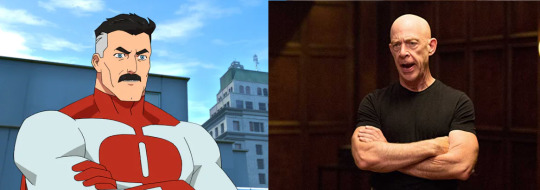
The Fletcher/Omni-Man parallel shows through their being incredibly harsh but extremely disciplined and principled, forcing people to become beyond even their own ideal selves (this via Omni-Man's tough-love teaching of Invincible — comically, Omni-Man was actually psychologically easier on Invincible than Fletcher was on Whiplash's Andrew character). Despite the show's attempts to villainize Omni-Man, he, like Fletcher and also like Breaking Bad's Walter White, becomes progressively more awesome, eventually representing a Spartan will, an unconquerable drive, and a realistic and martial understanding of a hero's role.
To the show's credit, while it wrote Omni-Man to be outright genocidal and from a culture of eugenicists (again, Spartan), they could not help but admire him and his "violence" and "naked force" (for a Starship Troopers reference), giving him a path to redemption. That redemption comes in part because — despite the show's attempt to be often realistic and violent — its decision to be directed at young adults via dumb jokes, petty relationship drama, the characters’ reckless lack of anonymity and security in their neighborhood (loudly taking off and landing right at the doorstep), and light indy music also made the portrayed violence far less literal. With a less literal violence, the real statement becomes not that Omni-Man really did kill so many people (though he certainly did kill those people within the show's plot) but that he was symbolically capable of terrible violence but could be reformed for good. That's the shortcoming with putting violence under demographic limitations. If it's a PG-13 Godzilla knocking down cities, the deaths in the many fallen skyscrapers don't matter so much (the audience will even forgive Godzilla for mass death if it happens mostly in removed spectacle), whereas if it's Cormac McCarthy envisioning a very realistic fiction, every death rides the edge of true trauma.
By showing light between the real and the symbolic, it is much easier to identify and agree with Omni-Man. For instance, when Robot (voiced by Zachary Quinto of Heroes and the newer Star Trek movies)
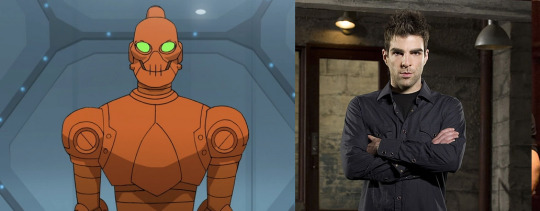
shows too much empathy for the revealed weakness of "Monster Girl" (voiced by Grey Griffin), the audience may have thought, "Pathetic," even before Omni-Man himself said it. And this because Omni-Man knows that true and powerful enemies (including himself) will not hesitate to use ultra-violence against these avenues of weakness. "Invincible" can make his Spider-Man quips while in lethal battles, but he does so while riding the edge of death — something that Omni-Man has to teach Invincible by riding him to the brink of his own.
Other Cast/Characters and Amazon's Hidden Budget
It was impressive how many big-name actors were thrown into this — a true hemorrhage of producer funding. Amazon has so far hidden the budget numbers, perhaps because they don't want people to know that the show (like many of its shows) represents a kind of loss-leader to jump-start its entertainment brand.
Aside from those already mentioned, the show borrows a number of actors from The Walking Dead (WD), including..
• Chad L. Coleman ("Martian Man"; "Tyreese" on WD),

• Khary Payton ("Black Samson"; "Ezekiel" on WD),

• Ross Marquand (several characters; "Aaron" on WD)

• Lauren Cohan ("War Woman"; "Maggie" on WD)
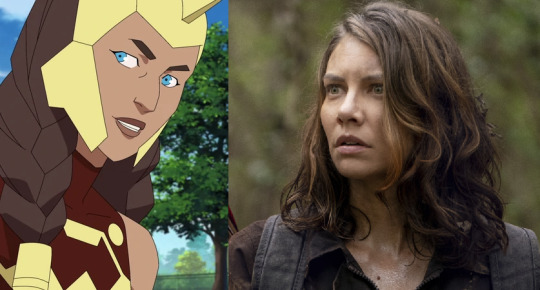
• Michael Cudlitz ("Red Rush"; "Abraham" on WD)
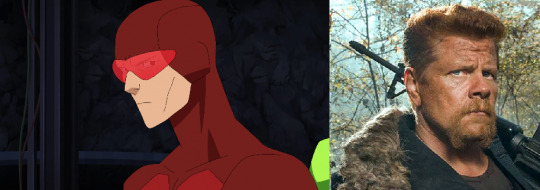
• Lennie James ("Darkwing"; "Morgan" on WD)
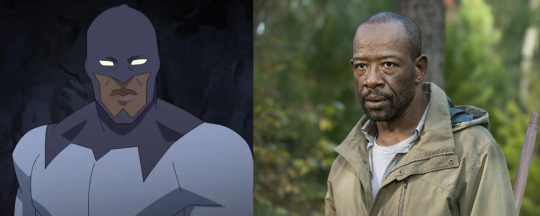
• Sonequa Martin-Green ("Green Ghost"; "Sasha" on WD)

There were also connections to Rick and Morty and Community, not just with Gillian Jacobs but also with...
• Justin Roiland ("Doug Cheston"), who voices both Rick and Morty in Rick and Morty,

• Jason Mantzoukas ("Rex"),

• Walton Goggins ("Cecil"),

• Chris Diamantopoulos (several characters),

• Clancy Brown ("Damien Darkblood"),
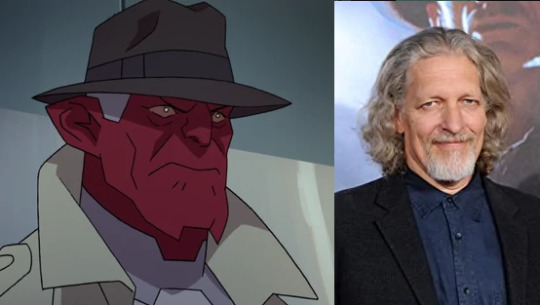
• Kevin Michael Richardson ("Mauler Twins"), and

• Ryan Ridley (writing)
That's a lot of overlap.
They even had Michael Dorn from Star Trek: TNG (1987–1994) (there he played Worf) and Reginald VelJohnson from Family Matters (1989–1998) and Die Hard (1988), and even Mark Hamill. Pretty much everyone in the voice cast was significant and known. Maybe Amazon got a discount for COVID since the actors could all do voice-work from home? ;)
Overall
Bad that it was for the Young Adult target demo but good for the infrequent adult themes and ultra-violence. Very high production value and a good watch for those who like dark superhero stories. I have heard that the comic gets progressively darker, which fits for Robert Kirkman, so it will likely be worth keeping up with this show.
24 notes
·
View notes
Text
MBS EPISODE EIGHHHHT
weak.
I hate to say it but I could feel it in my heart from the start. It had good moments but this episode just didn’t bring it home. I’m going to break this up into my usual notes and then some general evaluation.
Notes:
What is the deal with curtain and food? He has so many weird scenes with meals.. there’s probably some hidden meaning here but I don’t know what it is
And they didn’t get to chuck-root the school :(((((
Constance? Wants to pour acid on curtain’s feet
Haha I liked Kate’s little “Nyoope” when the recruiters found her
Martina redemption and the fighting tetherball team, sure
Jackson and Jillson get even more unhinged. they terrify me
We got Kate yeeting Constance up the tower, but her bucket had a built in rope motor somehow
WE GOT KATIE-KAT but we didn’t get Sorry it took me so long
And Milligan’s still moody instead of joyous
Go Constance, break the thing, yay
Number Two and Rhonda had some real shippy energy in this episode and PLEASE they are SISTERS
Two more close profile shots of curtain in this episode, one where he is physically shorter than Milligan but dominating the interaction, and one where he’s physically looking down at Reynie but Reynie’s getting to him.
Reynie has a heart to heart and curtain passes out. That’s different. Sticky even said, “it’s anger” and he was like “no, it’s vulnerability” oooooookay then.
The whisperer is not an intercom/loudspeaker. sheesh.
So the kiddos leave and the twins talk, resolving nothing, then curtain escapes
REYNIE AND MISS PERUMAL NO COMPLAINTS HERE *sobs*
Kate and Madge at the end <3
Constance refuses adoption!?!?!?!??! And no age reveal obviously
rip Sticky’s family redemption he’s going to the totally not made up Boatwright Academy now
Mr Benedict is like, I love you all, no snowball fight, the end.
SIKE Curtain, SQ, and a totally real engineer lady are on a BOAT. You know, I felt bad for the engineer this whole series, as she is portrayed as kind of doing the technical work hoping it’ll be used for good, while curtain abuses its practical application, but her mood really shifted in that last scene. She was like heheh hey guy that I know is definitely is evil, howabout this mysterious blueprint... are they really trying to set up the sequel. Some tree branches will have to get pretttty bent.
Evaluation: keep reading! (sorry it gets long)
To recap what I’ve said from the start, I think the casting is fantastic but the tone is wrong. The darker, more saturated filter, the isolating camera shots, and very understated music make things colder and stilted. This is a constant throughout the whole series. The book was warm, messy, and full of charm, which I didn’t feel watching the show.
characters were.. compromised?
Mr B starts off with a LIE about test winners going to Boatwright Academy. That undermines EVERYTHING he does from then on. “Regrettable but necessary” DOESN’T cut it. He’s also just so anxious and jittery instead of his gentile, kind, strong book self. Just from the show, they didn’t frame his genius very well. He seems more like a fool. Not really confidence-inspiring.
In the same way, Being directed to cheat is one thing, but Reynie should NOT have lied to SQ to manipulate him into seeing the forest or whatever. Yeah reynie felt bad about it and SQ called him on it, but this is like the core values of our protagonist team, the strong love for truth. Also, I feel like in the show Reynie’s leadership isn’t highlighted. Like, everyone else has their thing but you almost wonder why he’s framed as the main character. The girls got bonding and the boys got bonding but there was hardly opportunity for him to really bring the team together into a cohesive unit
Also, as much as I love Number Two’s life of crime (because it’s funny), she too should have that love of truth, but instead regularly does unlawful things. AND they never explained her eating, and even stopped having yellow clothes :(
Additionally, the side story of her and Rhonda’s friction (entertaining I suppose) also really changed the character dynamic. In the book, the adult team was unwavering and wise, a sturdy basis for the perilous missions of the children. But their internal strife, while adding drama, makes them seem unreliable and less absolutely good and trustworthy. And I think trust and integrity are key parts of the book’s solid narrative.
Constance’s refusal of the adoption felt wrong too. She was like, “Respectfully decline, but. I’ll stick around here.” I think they were trying to keep going with her contrariness, but it just comes across as foolish pride? Constance is a LITTLE GIRL. She DESERVES a FAMILY. SHE DESERVES A LOVING PARENT (and two wonderful sisters). Yeah family doesn’t have to be by blood OR lawful paperwork, but her actions in this scene really just. cuts off the feels at the knees. We KNOW she’s strong and independent but that doesn’t mean she HAS TO BE or even necessarily WANTS to be all the time. Over the course of the series we see her warming up to people, a kind word here, a little smile there, but this adoption refusal is.. harsh.
Then we’ve got Sticky. Yes, he struggles with the comfort of the whisperer. And he overcomes it. BUT in one of the earlier episodes, they had him fighting with the team, defending the whisperer, dismissing his friends... and I count this as betrayal. It may be extreme on my part, but I think he went too far. The Society is the Society. In the book he bested his fears for them and with their support. Yeah he desperately wanted to just give in but he had PRINCIPLES and knew why he couldn’t. His honor, his responsibility to stop curtain, and his loyalty to his friends got him though. But in the show he just dumped them. And then was like, oh oops jk I’m back. (I knowwwwww the book has the privilege of being able to explain characters’ thought processes and emotional states, while shows have to work with more tangible actions and words but stilll I did not Like That)
And finally, curtain wasn’t smart. He had hired people doing all the work. He just used it to his ends. Less evil genius and more manipulating creep. But this? I’m more ok with. As an villain, he got the job done. But this makes him less of a foil for Mr Benedict and more of an antagonist, if that makes sense. In the book they never knew each other, but were both alone in the world and greatly smart, and they chose verrry different paths. Whereas in the show he and B were always kind of opposites, warring in motivation and method from the start.
Let’s talk about the boss battle
(such as it was). I said it was weak and I meant it. The book is heart pounding. There is so much going on, and so many people in play, the narration jumping all over the place in real time, all culminating in that clash at the top of the tower.
Now, the show... the highs weren’t the highs. It felt more like checking off story points. Kate and constance outside - check. Resist the whisperer to stall for time - check. Milligan reveal - check. Reynie starting to figure out narcolepsy triggers - check. Constance shouting then you are the greatest fool of all - um, no, that didn’t happen. Constance defeating the whisperer - check. Curtain escapes - check.
We got zero action. No good fights. I know Emmy Deoliveira is a kid and I’m not mad at her for not being able to do action sequences or run with Constance piggyback. But there was almost no physical conflict on-screen, and that’s Kate’s real time to shine.
Also they had Number two and Rhonda in the tower ready to fight and then they just didn’t. All this build up for nothing.
Furthermore, and I think this is the biggest problem, there was no momentum. Yeah they cut from scene to scene, but the music and tone cut scene-to-scene too. So there was like, dramatic music, Kate’s ready to fight! Get hyped! and then cut to absolutely silent, mr curtain staring at someone. feel mildly disturbed. and then cut to Rhonda and Number two being friends and ready to fight! Aww! And yay! Get hyped! And then cut back to Sticky sitting in a chair, dead silent. It goes on like this.
The music, the urgency, should have carried throughout, building in intensity and desperation as the kids come together and curtain unravels more and more and then BAM! curtain down and OH NO! the whisperer and finally Constance’s “I... DON”T.... CARE!!!” and then the madcap escape from the island.
Watching, I just couldn’t get swept away. Storywise, they tied it all up and logically it made sense but the emotional culmination just wasn’t there.
It was over and done too quick. It fell flat. I didn’t feel the struggle, the suspense. And then they gave us a fabricated Mr B and Curtain conversation that didn’t really help anything.
And then the falling action had some nice moments but as I mentioned, the things with constance and sticky kind of made it feel less relieving, joyful, and sweet. I know a snowball fight is elaborate to set and film but I would have loved to see it.
Final thoughts
I can’t help but love the kids. I’ll say it again, I sure liked this casting. And for all the changes they had to make, the original central plot was there, and most of the characters were recognizable even with all the alterations. So I did have problems with some of that underlying integrity, as well as the overall tone and execution, but I also laughed at the little funny things, jammed to the title theme, and was excited to see this, my favorite book in the world, get more recognition. I can’t imagine how hard it would be to adapt a work of prose into an audiovisual medium, and considering how outlandish the book sometimes got, they gave it their best shot. I didn’t love it but I can recognize the accomplishment. In terms of faithful and well-made adaptations, on a scale of Percy Jackson to Harry Potter, I’d give The Mysterious Benedict Society a 6.5/10.
14 notes
·
View notes
Text
An attempt at listing everything “Problematic” with the HP-verse. And its relation to the story. Feel free to add more.
Goblins.
Somewhat infamous as an antisemitic thing, goblins have long since become a staple of fantasy-worlds everywhere. Them being included in HP is nothing really worth frowning about. However, placing them in the exclusive position of “greedy bankers” is very much not a good look since this brings them closer in line with the antisemitism that they originally spawned from.
That said, the goblins and their bank have little to no impact on the story. The few goblins we see barely have speaking-roles, and so it can likely be assumed that there was no intent to do something with this antisemitic portrayal of them.
House-elves.
Seemingly adapted from stories about the common fae-creature “brownies”, house-elves are presented as slaves who love doing household-chores but who can be abused by “nasty owners”. The only house-elf we see who wants freedom is treated like a crazy person, and the only person we see trying to campaign for their freedom is openly mocked by the narrative.
Despite common fanon, there's no indication that house-elves actually need to be “bonded” with anyone.
Considering that this attitude existed towards actual slaves in history, where black people were portrayed as “needing to be owned” but that decent folk shouldn't be “cruel” about doing so, this is a volatile mix of historical racism presented as if it isn't messed up.
The “crazy” house-elf who wanted freedom shows up on multiple occasions throughout the books, helping out his rescuer, until this finally kills him. It's a heroic sacrifice and it's treated as such, but his death is also used by the story to showcase how “noble” his rescuer was for actually rescuing a tortured slave.
Understandably, the situation with the house-elves is an extremely volatile topic, and it's hard to say with any certainty what the full intent behind them was.
Homosexuality.
There's one character who is supposedly homosexual. This character is an old man who never speaks of his sexuality in the story, but who dresses in flamboyant clothing and is never hinted at “having been married” despite his age. Towards the end of the story, there are hints that he had a romantic relationship with a man in his youth, which unfortunately ended in tragedy.
With Dumbledore being a reoccurring if distant character, it makes sense that he was never all that open about his personal experience with romance or sexuality, doubly so considering the trauma attached to his “first love”.
That said, considering that the person he fell in love with grew up to become “magical Hitler”, and that Dumbledore refused to indulge in romance ever since, the fact that this is the only homosexual relationship in the series means that this then serves to underline the idea that “homosexuality is an evil to overcome”.
Keeping in mind that this idea is what fuels things like “conversion therapy”, the fact that the series doesn't dispute the validity of this idea is very much not good. It can at its most extreme be interpreted as if the presence of the homosexual character is in fact designed to undermine the battles that current homosexual people face.
Gender-roles.
No girl in the entirety of the series asks a boy out. It's always the opposite. There's also the fact that the girls can access the boys' dorms but the boys can't access the girls'. This all implies that girls need to be sexually wary of boys, but that boys have no need for such worries.
Considering the many problems our society has with recognizing male rape-victims, or abuse-survivors, this doesn't paint a pretty picture. (Not to mention the transphobia that the author began spreading in the years since.)
That said, considering that this is a part of our culture that we're still struggling with, it's not unlikely that this wasn't in fact intended to portray much of anything at all, any more than a regular story about people “driving cars” would be intended to portray how Global Warming isn't anything to worry about.
It doesn't get a lot of screen-time, and it's unlikely that there was any real malice intended upon writing it.
Disabilities.
There's a man with a peg-leg and a missing eye, and one of the villains receive a hand-prosthetic. Other than that, no mention is made of any kind of disability in-story, but considering the great many stairs and distances involved it's unlikely that Hogwarts is in any way designed to be “accessible”.
Keeping in mind that magic in-setting is very good at solving “non-magical injuries”, a few assumptions can be made about people being “cured” of their disabilities even before arrival.
That said, nobody in-story ever makes any claim about being cured, so it's unlikely that there was any real thought put into this. And with how sparse “disability representation” is in media of today, it's likely that including such characters simply never occurred to the author.
This isn't necessarily a good thing, but it seemingly wasn't done out of any malice.
Obesity.
Whilst obesity is the most obvious indication of “evil” characters in the story, it should be noted that most everyone “evil” is described as unattractive. Evil characters are grotesque or horrifying or simply ugly, regardless of if they're “thick” or “thin”.
That said, fat-shaming is a very serious problem in our society, especially within medicine. And seeing its prevalence in a series aimed at children and young adults isn't exactly a good thing.
Considering how so many “non-good” characters are described as unattractive, regardless of their body-types, it's hard to say exactly how much of it is intended to actually shame overweight people, and how much of it is the “Disney-effect” of goodness somehow making a person prettier whilst wickedness makes them uglier.
6 notes
·
View notes
Text
A Streetcar Named Marge

The Tennessee Williams play, A Streetcar Named Desire, was one of the most celebrated American productions of the 20th century and inspired many films and revivals. When in junior high school in the 90s, I was introduced to the story in a very interesting way. It wasn't through the many films, a revival of the play, or even an English class. My introduction to the story was through a parody done on The Simpsons in October of 1992. I had just started my 7th grade year at Fesler Jr. High School and being at a new school meant meeting new friends. I was lucky to have a large group of people from grade school, but I found friends in a new group with a shared love of The Simpsons. At first we had a fascination with the show because the said minor swear words like "damn" and "hell." Bart Simpson was especially interesting because some part of our pre-teen brains wanted to fight back against authority like he did.
This particular episode was interesting to me because most of the series had focused on Homer and the kids and Marge was generally the straight character. She is embarrassed of her husband and constantly shamed by her children and it had not occurred to me that there was probably an underlying anger that was slowly building. When she is given an opportunity to play the part of Blanche in a local musical version of A Streetcar Named Desire called simply Oh! Streetcar. She gets a chance to fight back against a suppressive, toxic character and she relishes. I remember specifically a part where she attacks the antagonist with a broken and she wants to keep practicing that scene because it is so cathartic. It wasn't until I was an adult in the psychology program that I realized how bad a life Marge was portrayed as having and how toxic a husband that Homer Simpson was. I just thought he was funny because he was stupid, but he really had a negative effect on her life.
As the show progressed, Homer grew as a character and became less toxic, but he was just a terrible husband during the earlier seasons. The undermining abusive husband in the actual play was much worse than Homer in that he was aggressively abusive both physically and mentally to everyone around him. In fact, I would say that Stanley Kowalski is one of the worst villains in movie history. Everything he does was intended to harm and belittle others. In that light, I think that Marge just needed an outlet to blow off some steam because Homer would never harm her. He was just too ignorant to realize the effect he had on those around him.
I finally saw both the movie version and the actual play of A Streetcar Named Desire in my twenties and they were both very impressive. Both were a little difficult to watch because I don't like dramas with drunken contemptuous antagonists. This constant use of blame, gaslighting, and revenge as a lifestyle is foreign to me and it hurts me physically to see others suffer from it. In fact, the four biggest predictors of divorce were all of Stanley's major character traits: criticism, defensiveness, withdrawal, and contempt. Throw in some alcoholism and you have yourself toxic relationship bingo.
It is a powerful story and I am glad that I was gently introduced to it as a kid through the comedy of The Simpsons. I am going to rewatch the film for a review in the next week, but I also think I am going to find that episode of The Simpsons for a bit of nostalgia. I know it is not the same quality as a Tennessee Williams play, but I personally look forward to the episode of The Simpsons more.
3 notes
·
View notes
Text
Comparing ATLA’s Jet to Cowboy Bebop’s Spike
(this is so late, but. Happy birthday @the-hot-zone, hope you had an amazing day)
In my opinion, Cowboy Bebop is one of the greatest shows ever created. It hits a lot of my personal favorite attributes in a TV show: cowboys, fantastic music, absolutely spectacular animation, really deep themes and characters with rich inner lives, worldbuilding that’s thought out. Simply put, it’s a masterpiece.
I started watching Bebop this summer, at the height of the ATLA Renaissance, and the first thing I noticed about protagonist Spike Spiegel is that he looked a hell of a lot like Jet from ATLA. And it wasn’t just the looks either: like Jet, Spike is the leader of a ragtag group of misfits living on the fringes of society. Like Jet, Spike is a smooth talker. Like Jet, Spike is compassionate and cares for other people, and like Jet, the world has hardened Spike to the point where his virtues can still lead him down the wrong path. And while Jet isn’t named for Spike, there’s a character in Bebop named Jet (he sort of plays the right hand person role that Smellerbee plays for Jet in ATLA.) They’re not completely similar--Spike isn’t fighting for anybody’s liberation, whereas for Jet that’s a core aspect of his character--but it was enough to make me wonder about how Jet was designed and how much influence Bebop had on his character design and on ATLA as a whole, and whether looking at Spike can illuminate some of the conversations we’ve been having about Jet.
A little about the inspiration and process of ATLA: Bryan and Michael were working on shows like Family Guy when they decided they wanted to make something more sincere and more cinematic. They were both really inspired by anime. Bryan said “Back in the late '90s I was getting pretty disillusioned with working on sitcoms -- then I saw Princess Mononoke and I was emboldened. My heart was so much closer to that kind of story, those kinds of characters and that type of tone. After that, Cowboy Bebop really inspired us in terms of being a great example of an epic series that had a wide breadth of tones. Then FLCL came along and rewrote the rules for everything, as far as I'm concerned!” I haven’t seen FLCL, I’ll admit, but having seen both Bebop and Princess Mononoke--yeah, I get that. Both are incredible pieces of art that, for me personally, make me want to push myself as an artist, and I cannot recommend both enough if you haven’t seen them already.
So, Bryan and Michael decide they want to make something inspired by shows like Bebop and movies like Princess Mononoke, they get a pilot order from Nickelodeon and, as is custom at the time, they start reaching out to East Asian animation studios to help them with the animation. This video is a great source for how ATLA in particular interacted in this environment, but suffice to say that Bryan built a relationship with the studio that did a lot of work for ATLA, JM Animation, and gave them a lot of creative freedom in making the visuals of the show. This included designing Jet and the rest of the Freedom Fighters.

[ID: An image of Jet from ATLA from the shoulders up against a sky background fading from blue at the top to white at the bottom. He had dark skin, shaggy black hair, black eyes, eyebrows turned way up, a smirk on his face, and some wheat in his mouth. He is wearing a red jacket with a gray popped collar. End ID]
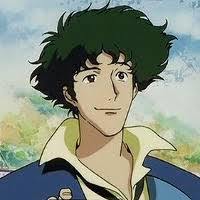
[ID: An image of Spike from Cowboy Bebop from the shoulders up against a sky blue background with trees behind him. He has shaggy dark brown hair that has a slight bit more curl in it than Jet’s, dark brown eyes, light skin, and a closed mouth smile on his face. He is wearing a blue suit with a yellow shirt that has a popped collar, and a skinny black tie/ End ID]
So, let’s look at the character design. Both Spike and Jet have these long, angular faces, shaggy dark hair, long necks, broad shoulders, dark eyes, some popped collar element to their attire, etc. While both characters are pretty tall and lanky, Spike’s height is more immediately obvious than Jet’s--in fact, I wouldn’t think of Jet as a tall character had I not seen some fandom height comparisons. The most obvious and immediate differences between how the characters physically look are their clothes, which are very different (likely due to the setting--ATLA is set in a proto-industrial war-torn society and Jet in particular has had to scavenge his clothes from Fire Nation troops, while Bebop is a space epic set in the far future), the lack of mouth wheat for Spike, Spike’s incredibly normal looking eyebrows versus Jet’s adorable long division eyebrows, and, of course, their skin tones. Colorism is something that people bring up a lot when talking about Jet’s character, and I have to wonder why Jet, a character that was so clearly inspired by this light-skinned character who was morally ambiguous in Bebop, was made darker-skinned when explicitly coded as a “villain” in ATLA.
In fact, colorism is a super important aspect of how Jet and Spike’s stories are told. To its credit, ATLA has two MCs (Sokka and Katara) with dark skin (not that the fanartists who whitewash them notice) while Bebop has just one (Ed). However, it’s important to note that Sokka and Katara are each portrayed in ways that Aang or other lighter-skinned characters in the show simply aren’t. For example, despite both characters being literal teenagers, they are sexualized within the text of the show. Another example of the colorism in ATLA is, of course, Jet, a Brown boy leading a resistance against oppressive colonialist imperialist forces, being so unambiguously vilified. Yes, within the text, Jet has some sense of complexity, especially in Book 2, but even that is undermined by his death at the hands of the Dai Li. Jet is never given the subjectivity of a character like Zuko. In fact, it’s pretty clear that Jet’s redemption and subsequent death happens when it does to demonstrate what Zuko is capable of if he makes the right choice. Whether or not this is a good decision writing-wise is another discussion, but the fact of the matter is that in using Jet to further Zuko’s arc, bryke used a Brown teenage boy/victim of imperialist violence to prop up the narrative of a light-skinned prince/perpetrator of imperial violence. This is not to say that Zuko shouldn’t have been redeemed or that Jet shouldn’t have died or that the narrative shouldn’t have dedicated time and attention to Zuko’s story, but it is to say that ultimately, the writers of the show decided that Jet’s subjectivity was a tool to further Zuko’s actualization.
Contrast this to Spike. Bebop is about a lot of things, but a core part of it is exploring Spike’s backstory and way of looking at the world. It’s part of what makes the show the show. It’s the thing that keeps you liking the guy even when he says or does something absolutely unconscionable. Nothing in the show is more important than Spike’s subjectivity. The show may have individual episodes that focus on the other main characters, but it’s pretty clear that it’s really *about* Spike. Where does Spike come from? What is his obsession with the past? Why do all these people want to kill him? Who is Julia? These are all prescient questions that I had as a viewer of Bebop, and these were questions that were not only important to understanding Spike Spiegel, but to understanding the narrative that the writers, director, and animators are telling. Bebop is nothing without Spike’s subjectivity, and the people behind the show invest in his narrative even though he does some pretty horrible things! (kills many people, is part of a crime syndicate at one point, says some pretty misogynistic crap, hell, the whole concept of the show is that he and his buddies hunt people down for money.) As I said before, Spike is morally ambiguous, an antihero, and the people behind Bebop run with that, because that is an integral part of the story that they’re telling.
You could certainly argue that ATLA, being a show for children, needs clear heroes and villains, to be unambiguous in its depiction of right and wrong. And to an extent that would be correct. But let’s not forget that ATLA is not shy in its depiction of morally ambiguous characters. That’s an integral part of what the show is. Characters like Zuko, Iroh, Mai, Azula, and Ty Lee are beloved despite (or perhaps because of) their complex moral frameworks. Zuko, Mai, and Ty Lee in particular move between designations of villain, victim, and hero pretty fluidly (Iroh and Azula are two other conversations in themselves.) I personally am okay, and in fact delighted, to have Zuko, Mai, Azula, and Ty Lee in the show because I think their stories and the ways that they move between evil, good, and morally gray are incredibly compelling. We know why they act the way they do, and we can condemn or validate their actions while always knowing exactly where they’re coming from.
But then I see Jet. Jet, whose village was burned down by the Fire Nation. Jet, who survived by himself and helped 5 other people survive along the way, while leading an organized resistance against the Fire Nation on wits alone. Jet, who somehow ended up in Ba Sing Se, his new family cut in half, wanting to start over. So much of him is a blank slate. Where Spike in Bebop, or Zuko, Iroh, Mai, Azula, and Ty Lee in ATLA, get fleshed out, have the writers convey specific information that helps the audience understand their actions and motivations, even if they’re wrong, Jet never gets that sort of care in his narrative. Jet never gets to be the center of ATLA, even for a moment, even in his own death. There’s always something more pressing, something more meaningful, than Jet. You could argue (I certainly would) that the show would be better if we spent more time with him, if the writers cared to understand him, but unlike Bebop and Spike, the show doesn’t revolve around the audience understanding Jet. The story is coherent without him. In book 3, despite the fact that Jet sacrificed his life for them, the Gaang only brings up Jet once, and that’s to condemn him. Jet’s story is a tragedy, an important one, but only insofar as it props up other pieces of the narrative. And that’s the most tragic part of it.
#jet#atla#cowboy bebop#am i doing this correctly?#i started this like a month ago and i'm pretty sure this is what I intended to say originally but not 100%#anyway happy birthday Zone! welcome to the majors#also incredible that i found such similar pictures of Jet and Spike#but like the difference is that Jet is smirking 'evilly' (he's not evil he's a child) while Spike's looking soft and happy#like that's it that's the meta#meta#atla meta
52 notes
·
View notes